Exploring the prevalence of child abuse in foster care homes
VerifiedAdded on 2019/12/03
|28
|2829
|164
Report
AI Summary
The assignment content outlines a qualitative research project on child abuse. The researcher will conduct secondary data collection using various sources such as books, journals, online articles, and government reports. Thematic analysis will be used to analyze the collected data. Reliability and validity are crucial aspects that will be considered during data collection. Research ethics will also be practiced, including proper citation of work, respect for human rights, compliance with the law, and avoiding plagiarism. The project's structure will be presented in a Gantt chart format.
Contribute Materials
Your contribution can guide someone’s learning journey. Share your
documents today.

RESEARCH PROJECT
Secure Best Marks with AI Grader
Need help grading? Try our AI Grader for instant feedback on your assignments.
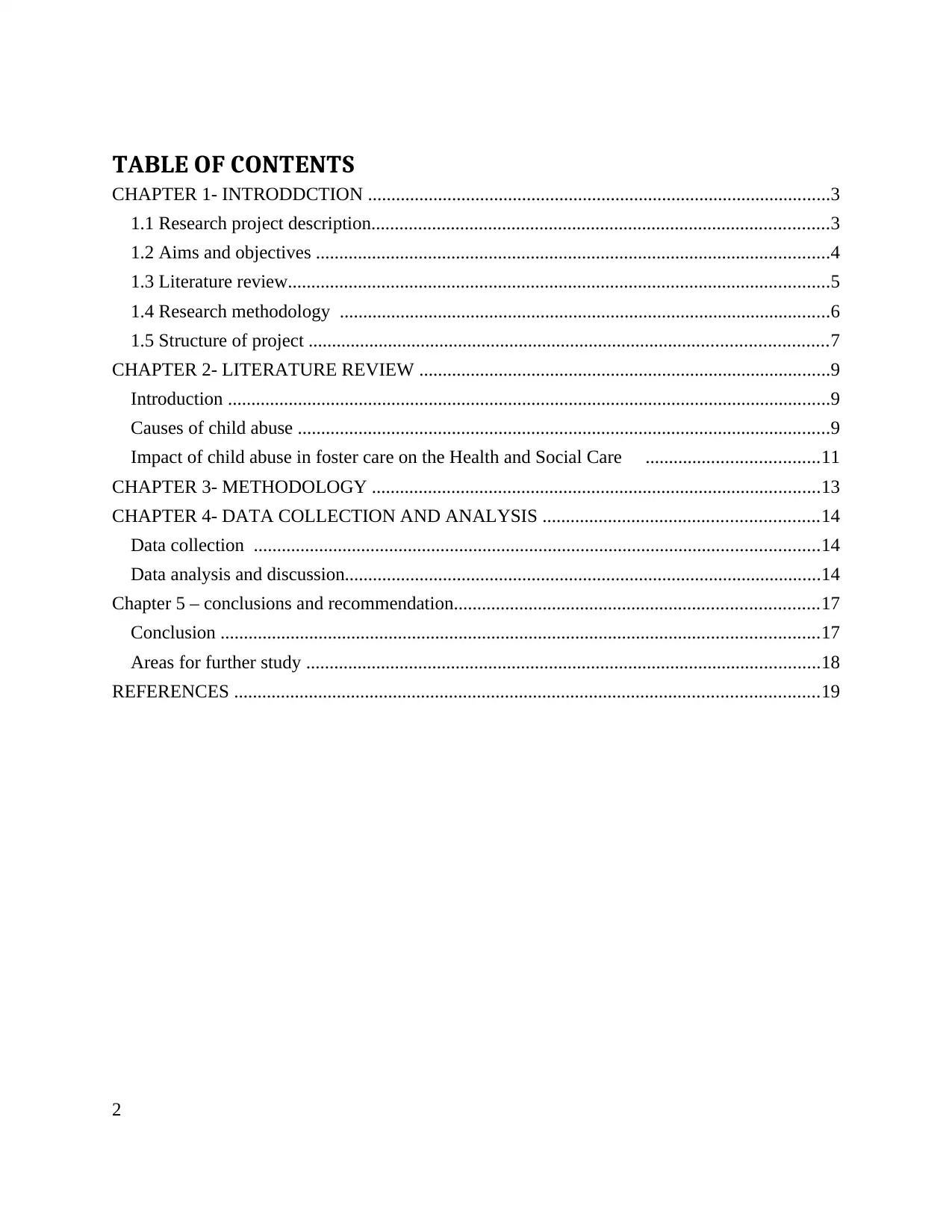
TABLE OF CONTENTS
CHAPTER 1- INTRODDCTION ...................................................................................................3
1.1 Research project description..................................................................................................3
1.2 Aims and objectives ..............................................................................................................4
1.3 Literature review....................................................................................................................5
1.4 Research methodology .........................................................................................................6
1.5 Structure of project ...............................................................................................................7
CHAPTER 2- LITERATURE REVIEW ........................................................................................9
Introduction .................................................................................................................................9
Causes of child abuse ..................................................................................................................9
Impact of child abuse in foster care on the Health and Social Care .....................................11
CHAPTER 3- METHODOLOGY ................................................................................................13
CHAPTER 4- DATA COLLECTION AND ANALYSIS ...........................................................14
Data collection .........................................................................................................................14
Data analysis and discussion......................................................................................................14
Chapter 5 – conclusions and recommendation..............................................................................17
Conclusion ................................................................................................................................17
Areas for further study ..............................................................................................................18
REFERENCES .............................................................................................................................19
2
CHAPTER 1- INTRODDCTION ...................................................................................................3
1.1 Research project description..................................................................................................3
1.2 Aims and objectives ..............................................................................................................4
1.3 Literature review....................................................................................................................5
1.4 Research methodology .........................................................................................................6
1.5 Structure of project ...............................................................................................................7
CHAPTER 2- LITERATURE REVIEW ........................................................................................9
Introduction .................................................................................................................................9
Causes of child abuse ..................................................................................................................9
Impact of child abuse in foster care on the Health and Social Care .....................................11
CHAPTER 3- METHODOLOGY ................................................................................................13
CHAPTER 4- DATA COLLECTION AND ANALYSIS ...........................................................14
Data collection .........................................................................................................................14
Data analysis and discussion......................................................................................................14
Chapter 5 – conclusions and recommendation..............................................................................17
Conclusion ................................................................................................................................17
Areas for further study ..............................................................................................................18
REFERENCES .............................................................................................................................19
2

CHAPTER 1- INTRODUCTION
1.1 Research project description
Rationale
The rationale of doing this project is high incidence of child abuse which has significant
negative consequences in the life of a child. When young, the life of a human revolves around
his parents or primary care givers. A child seeks safety, love, understanding, security, support
and nurturance from his parents or care givers. Trust is the core of a child's relationship with
parents/guardian or carer. Child abuse violates the trust in the relationship and gives birth to the
feelings of betrayal, thereby, leading to the development of a negative schema. This negative
schema impacts the capacity of an individual to establish and sustain significant attachments
throughout life. Child abuse makes a person display a type of behavior which not only threatens
but also disrupts the close relationships. There is the need to reflect on this issue and understand
the causes that lead to the high incidence of abuse. This is the rationale behind undertaking the
research project (Greeson et.al., 2011; Zito et.al., 2008).
Definition of key concepts and theories
Child abuse- It is defined as any action which is undertaken by another person whether
adult or child, which leads to significant emotional, physical or sexual harm to a child (Child
abuse and neglect, 2015). When a parent or carer causes injury, emotional harm or death of a
child through an action; or by failing to act, it is included in child abuse.
There are various types of child abuse. Physical abuse is the bodily harm inflicted on a
child. Neglect is another type of abuse which involves absence of parental care. Emotional abuse
is when a child is subjected to actions and behavior which cause mental anguish or deficits.
Sexual abuse refers to forcing or enticing a child to take part in sexual activities (What is child
abuse?, 2015).
Foster care- It is defined as a system characterized by placing a minor into a group home,
private home or ward. These are state certified care givers and are referred as “foster parents”.
Government or a social service agency is responsible for arranging the placement of a child to
foster care (Zito et.al., 2008).
3
1.1 Research project description
Rationale
The rationale of doing this project is high incidence of child abuse which has significant
negative consequences in the life of a child. When young, the life of a human revolves around
his parents or primary care givers. A child seeks safety, love, understanding, security, support
and nurturance from his parents or care givers. Trust is the core of a child's relationship with
parents/guardian or carer. Child abuse violates the trust in the relationship and gives birth to the
feelings of betrayal, thereby, leading to the development of a negative schema. This negative
schema impacts the capacity of an individual to establish and sustain significant attachments
throughout life. Child abuse makes a person display a type of behavior which not only threatens
but also disrupts the close relationships. There is the need to reflect on this issue and understand
the causes that lead to the high incidence of abuse. This is the rationale behind undertaking the
research project (Greeson et.al., 2011; Zito et.al., 2008).
Definition of key concepts and theories
Child abuse- It is defined as any action which is undertaken by another person whether
adult or child, which leads to significant emotional, physical or sexual harm to a child (Child
abuse and neglect, 2015). When a parent or carer causes injury, emotional harm or death of a
child through an action; or by failing to act, it is included in child abuse.
There are various types of child abuse. Physical abuse is the bodily harm inflicted on a
child. Neglect is another type of abuse which involves absence of parental care. Emotional abuse
is when a child is subjected to actions and behavior which cause mental anguish or deficits.
Sexual abuse refers to forcing or enticing a child to take part in sexual activities (What is child
abuse?, 2015).
Foster care- It is defined as a system characterized by placing a minor into a group home,
private home or ward. These are state certified care givers and are referred as “foster parents”.
Government or a social service agency is responsible for arranging the placement of a child to
foster care (Zito et.al., 2008).
3
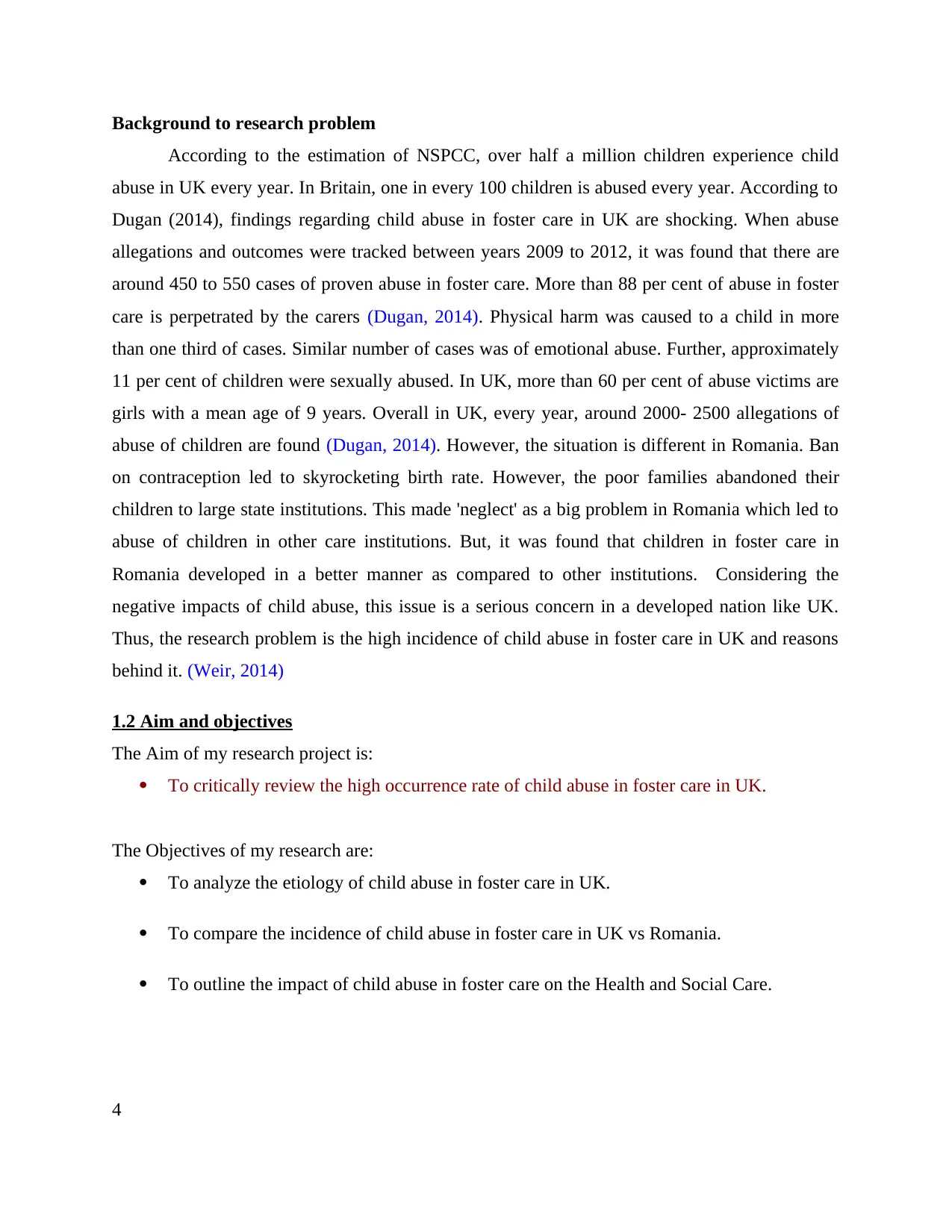
Background to research problem
According to the estimation of NSPCC, over half a million children experience child
abuse in UK every year. In Britain, one in every 100 children is abused every year. According to
Dugan (2014), findings regarding child abuse in foster care in UK are shocking. When abuse
allegations and outcomes were tracked between years 2009 to 2012, it was found that there are
around 450 to 550 cases of proven abuse in foster care. More than 88 per cent of abuse in foster
care is perpetrated by the carers (Dugan, 2014). Physical harm was caused to a child in more
than one third of cases. Similar number of cases was of emotional abuse. Further, approximately
11 per cent of children were sexually abused. In UK, more than 60 per cent of abuse victims are
girls with a mean age of 9 years. Overall in UK, every year, around 2000- 2500 allegations of
abuse of children are found (Dugan, 2014). However, the situation is different in Romania. Ban
on contraception led to skyrocketing birth rate. However, the poor families abandoned their
children to large state institutions. This made 'neglect' as a big problem in Romania which led to
abuse of children in other care institutions. But, it was found that children in foster care in
Romania developed in a better manner as compared to other institutions. Considering the
negative impacts of child abuse, this issue is a serious concern in a developed nation like UK.
Thus, the research problem is the high incidence of child abuse in foster care in UK and reasons
behind it. (Weir, 2014)
1.2 Aim and objectives
The Aim of my research project is:
To critically review the high occurrence rate of child abuse in foster care in UK.
The Objectives of my research are:
To analyze the etiology of child abuse in foster care in UK.
To compare the incidence of child abuse in foster care in UK vs Romania.
To outline the impact of child abuse in foster care on the Health and Social Care.
4
According to the estimation of NSPCC, over half a million children experience child
abuse in UK every year. In Britain, one in every 100 children is abused every year. According to
Dugan (2014), findings regarding child abuse in foster care in UK are shocking. When abuse
allegations and outcomes were tracked between years 2009 to 2012, it was found that there are
around 450 to 550 cases of proven abuse in foster care. More than 88 per cent of abuse in foster
care is perpetrated by the carers (Dugan, 2014). Physical harm was caused to a child in more
than one third of cases. Similar number of cases was of emotional abuse. Further, approximately
11 per cent of children were sexually abused. In UK, more than 60 per cent of abuse victims are
girls with a mean age of 9 years. Overall in UK, every year, around 2000- 2500 allegations of
abuse of children are found (Dugan, 2014). However, the situation is different in Romania. Ban
on contraception led to skyrocketing birth rate. However, the poor families abandoned their
children to large state institutions. This made 'neglect' as a big problem in Romania which led to
abuse of children in other care institutions. But, it was found that children in foster care in
Romania developed in a better manner as compared to other institutions. Considering the
negative impacts of child abuse, this issue is a serious concern in a developed nation like UK.
Thus, the research problem is the high incidence of child abuse in foster care in UK and reasons
behind it. (Weir, 2014)
1.2 Aim and objectives
The Aim of my research project is:
To critically review the high occurrence rate of child abuse in foster care in UK.
The Objectives of my research are:
To analyze the etiology of child abuse in foster care in UK.
To compare the incidence of child abuse in foster care in UK vs Romania.
To outline the impact of child abuse in foster care on the Health and Social Care.
4
Secure Best Marks with AI Grader
Need help grading? Try our AI Grader for instant feedback on your assignments.
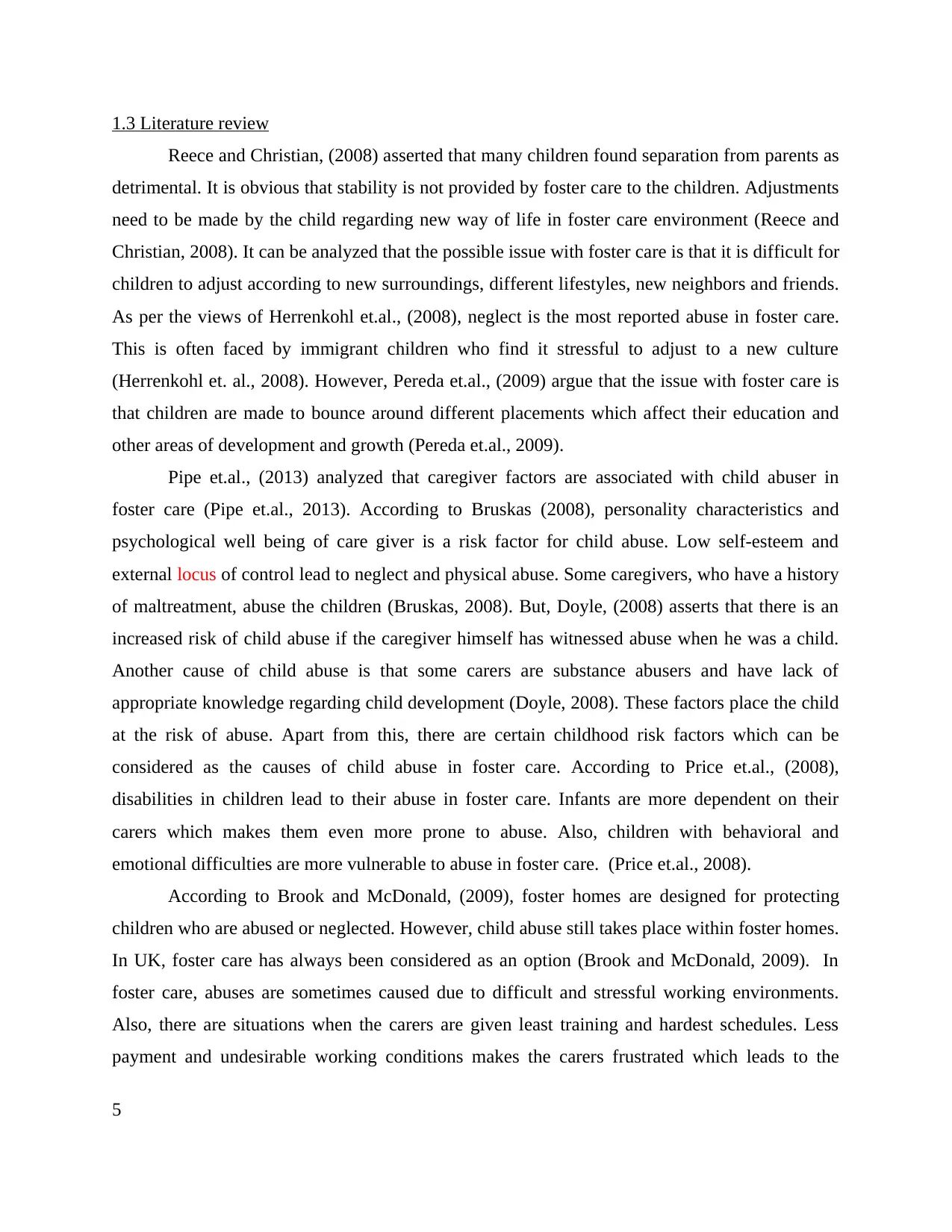
1.3 Literature review
Reece and Christian, (2008) asserted that many children found separation from parents as
detrimental. It is obvious that stability is not provided by foster care to the children. Adjustments
need to be made by the child regarding new way of life in foster care environment (Reece and
Christian, 2008). It can be analyzed that the possible issue with foster care is that it is difficult for
children to adjust according to new surroundings, different lifestyles, new neighbors and friends.
As per the views of Herrenkohl et.al., (2008), neglect is the most reported abuse in foster care.
This is often faced by immigrant children who find it stressful to adjust to a new culture
(Herrenkohl et. al., 2008). However, Pereda et.al., (2009) argue that the issue with foster care is
that children are made to bounce around different placements which affect their education and
other areas of development and growth (Pereda et.al., 2009).
Pipe et.al., (2013) analyzed that caregiver factors are associated with child abuser in
foster care (Pipe et.al., 2013). According to Bruskas (2008), personality characteristics and
psychological well being of care giver is a risk factor for child abuse. Low self-esteem and
external locus of control lead to neglect and physical abuse. Some caregivers, who have a history
of maltreatment, abuse the children (Bruskas, 2008). But, Doyle, (2008) asserts that there is an
increased risk of child abuse if the caregiver himself has witnessed abuse when he was a child.
Another cause of child abuse is that some carers are substance abusers and have lack of
appropriate knowledge regarding child development (Doyle, 2008). These factors place the child
at the risk of abuse. Apart from this, there are certain childhood risk factors which can be
considered as the causes of child abuse in foster care. According to Price et.al., (2008),
disabilities in children lead to their abuse in foster care. Infants are more dependent on their
carers which makes them even more prone to abuse. Also, children with behavioral and
emotional difficulties are more vulnerable to abuse in foster care. (Price et.al., 2008).
According to Brook and McDonald, (2009), foster homes are designed for protecting
children who are abused or neglected. However, child abuse still takes place within foster homes.
In UK, foster care has always been considered as an option (Brook and McDonald, 2009). In
foster care, abuses are sometimes caused due to difficult and stressful working environments.
Also, there are situations when the carers are given least training and hardest schedules. Less
payment and undesirable working conditions makes the carers frustrated which leads to the
5
Reece and Christian, (2008) asserted that many children found separation from parents as
detrimental. It is obvious that stability is not provided by foster care to the children. Adjustments
need to be made by the child regarding new way of life in foster care environment (Reece and
Christian, 2008). It can be analyzed that the possible issue with foster care is that it is difficult for
children to adjust according to new surroundings, different lifestyles, new neighbors and friends.
As per the views of Herrenkohl et.al., (2008), neglect is the most reported abuse in foster care.
This is often faced by immigrant children who find it stressful to adjust to a new culture
(Herrenkohl et. al., 2008). However, Pereda et.al., (2009) argue that the issue with foster care is
that children are made to bounce around different placements which affect their education and
other areas of development and growth (Pereda et.al., 2009).
Pipe et.al., (2013) analyzed that caregiver factors are associated with child abuser in
foster care (Pipe et.al., 2013). According to Bruskas (2008), personality characteristics and
psychological well being of care giver is a risk factor for child abuse. Low self-esteem and
external locus of control lead to neglect and physical abuse. Some caregivers, who have a history
of maltreatment, abuse the children (Bruskas, 2008). But, Doyle, (2008) asserts that there is an
increased risk of child abuse if the caregiver himself has witnessed abuse when he was a child.
Another cause of child abuse is that some carers are substance abusers and have lack of
appropriate knowledge regarding child development (Doyle, 2008). These factors place the child
at the risk of abuse. Apart from this, there are certain childhood risk factors which can be
considered as the causes of child abuse in foster care. According to Price et.al., (2008),
disabilities in children lead to their abuse in foster care. Infants are more dependent on their
carers which makes them even more prone to abuse. Also, children with behavioral and
emotional difficulties are more vulnerable to abuse in foster care. (Price et.al., 2008).
According to Brook and McDonald, (2009), foster homes are designed for protecting
children who are abused or neglected. However, child abuse still takes place within foster homes.
In UK, foster care has always been considered as an option (Brook and McDonald, 2009). In
foster care, abuses are sometimes caused due to difficult and stressful working environments.
Also, there are situations when the carers are given least training and hardest schedules. Less
payment and undesirable working conditions makes the carers frustrated which leads to the
5

development of abusive tendencies. It has further been found that child abuse is more common in
public residential care rather than the children who are present in private residential care homes.
(Refer appendix )
Impact of child abuse in foster care on HSC
The child abuse carried out in foster care homes puts additional burden on health and
social care. This is as increased services by psychiatrist are to be given to these children. It thus
puts under pressure on psychology department of foster care homes (Zito et.al., 2008). There are
various kinds of development issues faced by children who are living in foster care homes. From
the research, it has been found that the major impacts of child abuse in foster care are emotional
problems, lack of self-esteem, distrust on others, increase aggressiveness, increase the use of
drugs and alcohols, poor mental health, unhappiness, affect physical health, start to isolate from
the other people, changing in behavior, anxiety disorders, eating and sleeping disorders etc
(Reece and Christian, 2008). On the other hand, another impact of child abuse in foster care on
HSC are increase suicide attempts, personality disorders, self-harming behavior, post-traumatic
stress etc. Therefore, it can be said that the child abuse in foster care on HSC has made the
negative impact on physical and mental health of children.
1.4 Research methodology
Research methodology comprises of the process of data collection and analysis with the
help of which, the aim and objectives of research can be attained (Harrison and Reilly, 2011).
For accomplishing this research, I will use a number of research methods such as research
approach, type, data collection, analysis, validity and reliability etc.
Research philosophy
There would be a use of interpretive philosophy so as to identify the truths and facts that are
related to working of foster care homes. The philosophy will thus play a key role to produce the
end result. Hence for the present study interpretive philosophy is the best so as to make sense of
the events that take place in foster homes (Reece and Christian, 2008).
Research approach
In present study there has been a use of deductive approach as the study will move general to
specific. This is being overall foster care homes present in UK to a specific one being child abuse
6
public residential care rather than the children who are present in private residential care homes.
(Refer appendix )
Impact of child abuse in foster care on HSC
The child abuse carried out in foster care homes puts additional burden on health and
social care. This is as increased services by psychiatrist are to be given to these children. It thus
puts under pressure on psychology department of foster care homes (Zito et.al., 2008). There are
various kinds of development issues faced by children who are living in foster care homes. From
the research, it has been found that the major impacts of child abuse in foster care are emotional
problems, lack of self-esteem, distrust on others, increase aggressiveness, increase the use of
drugs and alcohols, poor mental health, unhappiness, affect physical health, start to isolate from
the other people, changing in behavior, anxiety disorders, eating and sleeping disorders etc
(Reece and Christian, 2008). On the other hand, another impact of child abuse in foster care on
HSC are increase suicide attempts, personality disorders, self-harming behavior, post-traumatic
stress etc. Therefore, it can be said that the child abuse in foster care on HSC has made the
negative impact on physical and mental health of children.
1.4 Research methodology
Research methodology comprises of the process of data collection and analysis with the
help of which, the aim and objectives of research can be attained (Harrison and Reilly, 2011).
For accomplishing this research, I will use a number of research methods such as research
approach, type, data collection, analysis, validity and reliability etc.
Research philosophy
There would be a use of interpretive philosophy so as to identify the truths and facts that are
related to working of foster care homes. The philosophy will thus play a key role to produce the
end result. Hence for the present study interpretive philosophy is the best so as to make sense of
the events that take place in foster homes (Reece and Christian, 2008).
Research approach
In present study there has been a use of deductive approach as the study will move general to
specific. This is being overall foster care homes present in UK to a specific one being child abuse
6
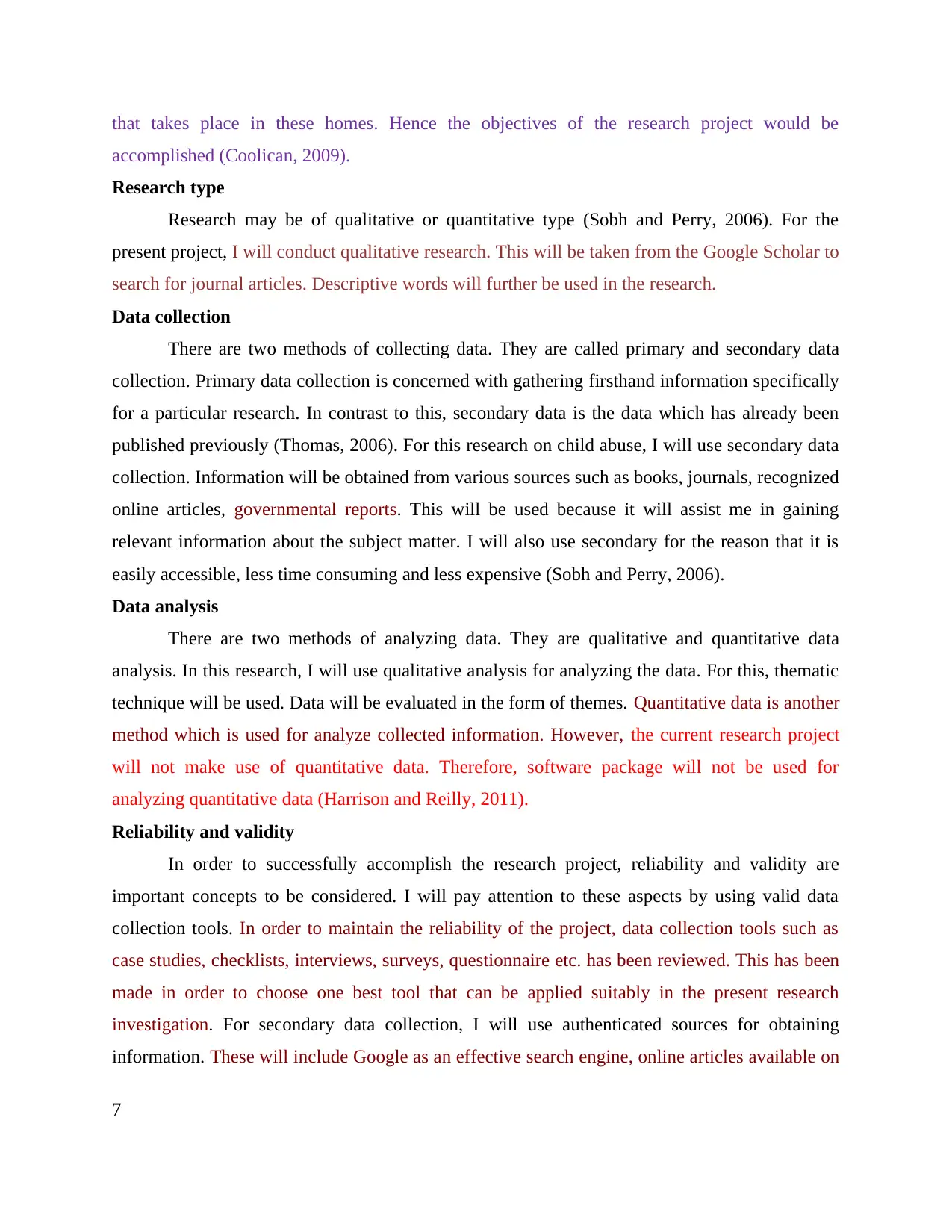
that takes place in these homes. Hence the objectives of the research project would be
accomplished (Coolican, 2009).
Research type
Research may be of qualitative or quantitative type (Sobh and Perry, 2006). For the
present project, I will conduct qualitative research. This will be taken from the Google Scholar to
search for journal articles. Descriptive words will further be used in the research.
Data collection
There are two methods of collecting data. They are called primary and secondary data
collection. Primary data collection is concerned with gathering firsthand information specifically
for a particular research. In contrast to this, secondary data is the data which has already been
published previously (Thomas, 2006). For this research on child abuse, I will use secondary data
collection. Information will be obtained from various sources such as books, journals, recognized
online articles, governmental reports. This will be used because it will assist me in gaining
relevant information about the subject matter. I will also use secondary for the reason that it is
easily accessible, less time consuming and less expensive (Sobh and Perry, 2006).
Data analysis
There are two methods of analyzing data. They are qualitative and quantitative data
analysis. In this research, I will use qualitative analysis for analyzing the data. For this, thematic
technique will be used. Data will be evaluated in the form of themes. Quantitative data is another
method which is used for analyze collected information. However, the current research project
will not make use of quantitative data. Therefore, software package will not be used for
analyzing quantitative data (Harrison and Reilly, 2011).
Reliability and validity
In order to successfully accomplish the research project, reliability and validity are
important concepts to be considered. I will pay attention to these aspects by using valid data
collection tools. In order to maintain the reliability of the project, data collection tools such as
case studies, checklists, interviews, surveys, questionnaire etc. has been reviewed. This has been
made in order to choose one best tool that can be applied suitably in the present research
investigation. For secondary data collection, I will use authenticated sources for obtaining
information. These will include Google as an effective search engine, online articles available on
7
accomplished (Coolican, 2009).
Research type
Research may be of qualitative or quantitative type (Sobh and Perry, 2006). For the
present project, I will conduct qualitative research. This will be taken from the Google Scholar to
search for journal articles. Descriptive words will further be used in the research.
Data collection
There are two methods of collecting data. They are called primary and secondary data
collection. Primary data collection is concerned with gathering firsthand information specifically
for a particular research. In contrast to this, secondary data is the data which has already been
published previously (Thomas, 2006). For this research on child abuse, I will use secondary data
collection. Information will be obtained from various sources such as books, journals, recognized
online articles, governmental reports. This will be used because it will assist me in gaining
relevant information about the subject matter. I will also use secondary for the reason that it is
easily accessible, less time consuming and less expensive (Sobh and Perry, 2006).
Data analysis
There are two methods of analyzing data. They are qualitative and quantitative data
analysis. In this research, I will use qualitative analysis for analyzing the data. For this, thematic
technique will be used. Data will be evaluated in the form of themes. Quantitative data is another
method which is used for analyze collected information. However, the current research project
will not make use of quantitative data. Therefore, software package will not be used for
analyzing quantitative data (Harrison and Reilly, 2011).
Reliability and validity
In order to successfully accomplish the research project, reliability and validity are
important concepts to be considered. I will pay attention to these aspects by using valid data
collection tools. In order to maintain the reliability of the project, data collection tools such as
case studies, checklists, interviews, surveys, questionnaire etc. has been reviewed. This has been
made in order to choose one best tool that can be applied suitably in the present research
investigation. For secondary data collection, I will use authenticated sources for obtaining
information. These will include Google as an effective search engine, online articles available on
7
Paraphrase This Document
Need a fresh take? Get an instant paraphrase of this document with our AI Paraphraser
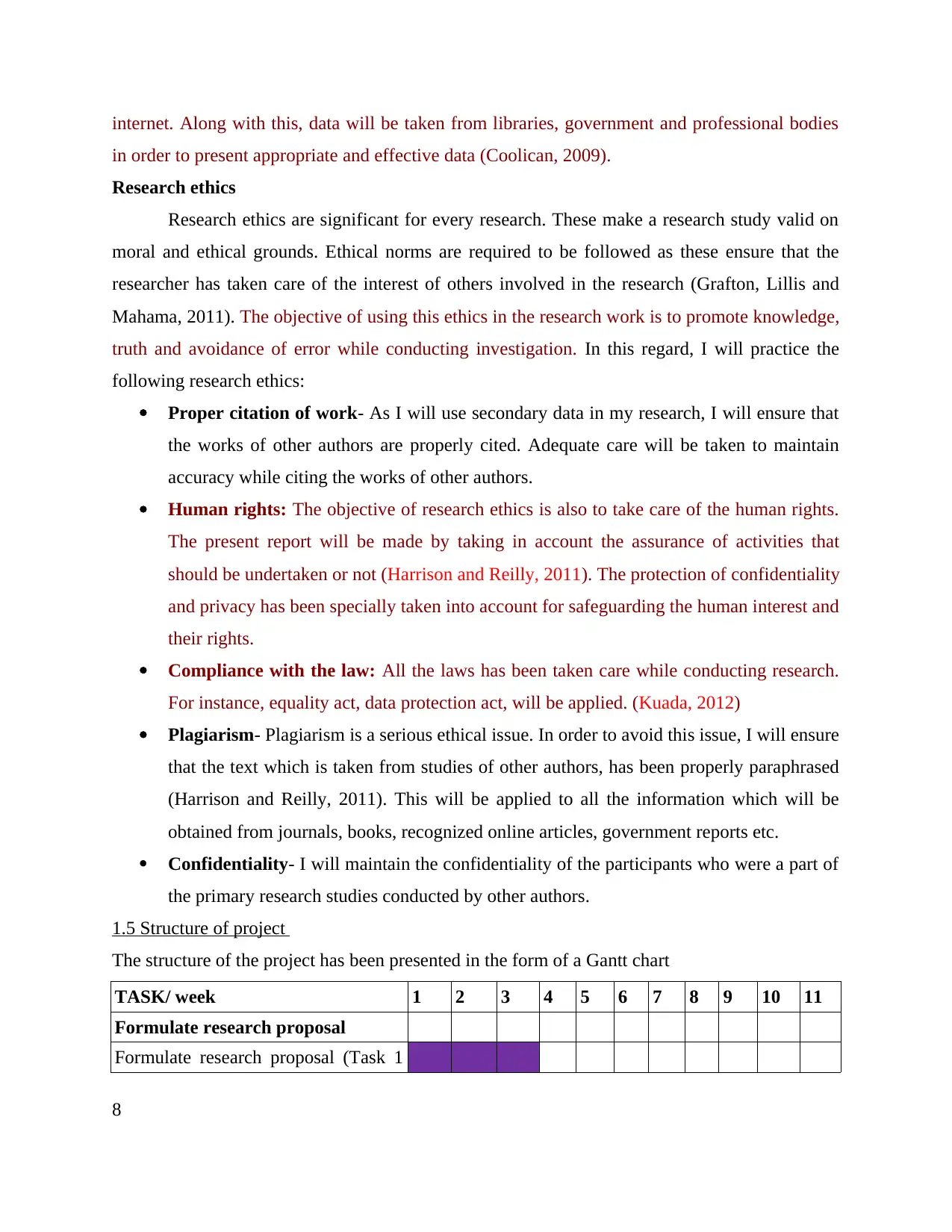
internet. Along with this, data will be taken from libraries, government and professional bodies
in order to present appropriate and effective data (Coolican, 2009).
Research ethics
Research ethics are significant for every research. These make a research study valid on
moral and ethical grounds. Ethical norms are required to be followed as these ensure that the
researcher has taken care of the interest of others involved in the research (Grafton, Lillis and
Mahama, 2011). The objective of using this ethics in the research work is to promote knowledge,
truth and avoidance of error while conducting investigation. In this regard, I will practice the
following research ethics:
Proper citation of work- As I will use secondary data in my research, I will ensure that
the works of other authors are properly cited. Adequate care will be taken to maintain
accuracy while citing the works of other authors.
Human rights: The objective of research ethics is also to take care of the human rights.
The present report will be made by taking in account the assurance of activities that
should be undertaken or not (Harrison and Reilly, 2011). The protection of confidentiality
and privacy has been specially taken into account for safeguarding the human interest and
their rights.
Compliance with the law: All the laws has been taken care while conducting research.
For instance, equality act, data protection act, will be applied. (Kuada, 2012)
Plagiarism- Plagiarism is a serious ethical issue. In order to avoid this issue, I will ensure
that the text which is taken from studies of other authors, has been properly paraphrased
(Harrison and Reilly, 2011). This will be applied to all the information which will be
obtained from journals, books, recognized online articles, government reports etc.
Confidentiality- I will maintain the confidentiality of the participants who were a part of
the primary research studies conducted by other authors.
1.5 Structure of project
The structure of the project has been presented in the form of a Gantt chart
TASK/ week 1 2 3 4 5 6 7 8 9 10 11
Formulate research proposal
Formulate research proposal (Task 1
8
in order to present appropriate and effective data (Coolican, 2009).
Research ethics
Research ethics are significant for every research. These make a research study valid on
moral and ethical grounds. Ethical norms are required to be followed as these ensure that the
researcher has taken care of the interest of others involved in the research (Grafton, Lillis and
Mahama, 2011). The objective of using this ethics in the research work is to promote knowledge,
truth and avoidance of error while conducting investigation. In this regard, I will practice the
following research ethics:
Proper citation of work- As I will use secondary data in my research, I will ensure that
the works of other authors are properly cited. Adequate care will be taken to maintain
accuracy while citing the works of other authors.
Human rights: The objective of research ethics is also to take care of the human rights.
The present report will be made by taking in account the assurance of activities that
should be undertaken or not (Harrison and Reilly, 2011). The protection of confidentiality
and privacy has been specially taken into account for safeguarding the human interest and
their rights.
Compliance with the law: All the laws has been taken care while conducting research.
For instance, equality act, data protection act, will be applied. (Kuada, 2012)
Plagiarism- Plagiarism is a serious ethical issue. In order to avoid this issue, I will ensure
that the text which is taken from studies of other authors, has been properly paraphrased
(Harrison and Reilly, 2011). This will be applied to all the information which will be
obtained from journals, books, recognized online articles, government reports etc.
Confidentiality- I will maintain the confidentiality of the participants who were a part of
the primary research studies conducted by other authors.
1.5 Structure of project
The structure of the project has been presented in the form of a Gantt chart
TASK/ week 1 2 3 4 5 6 7 8 9 10 11
Formulate research proposal
Formulate research proposal (Task 1
8
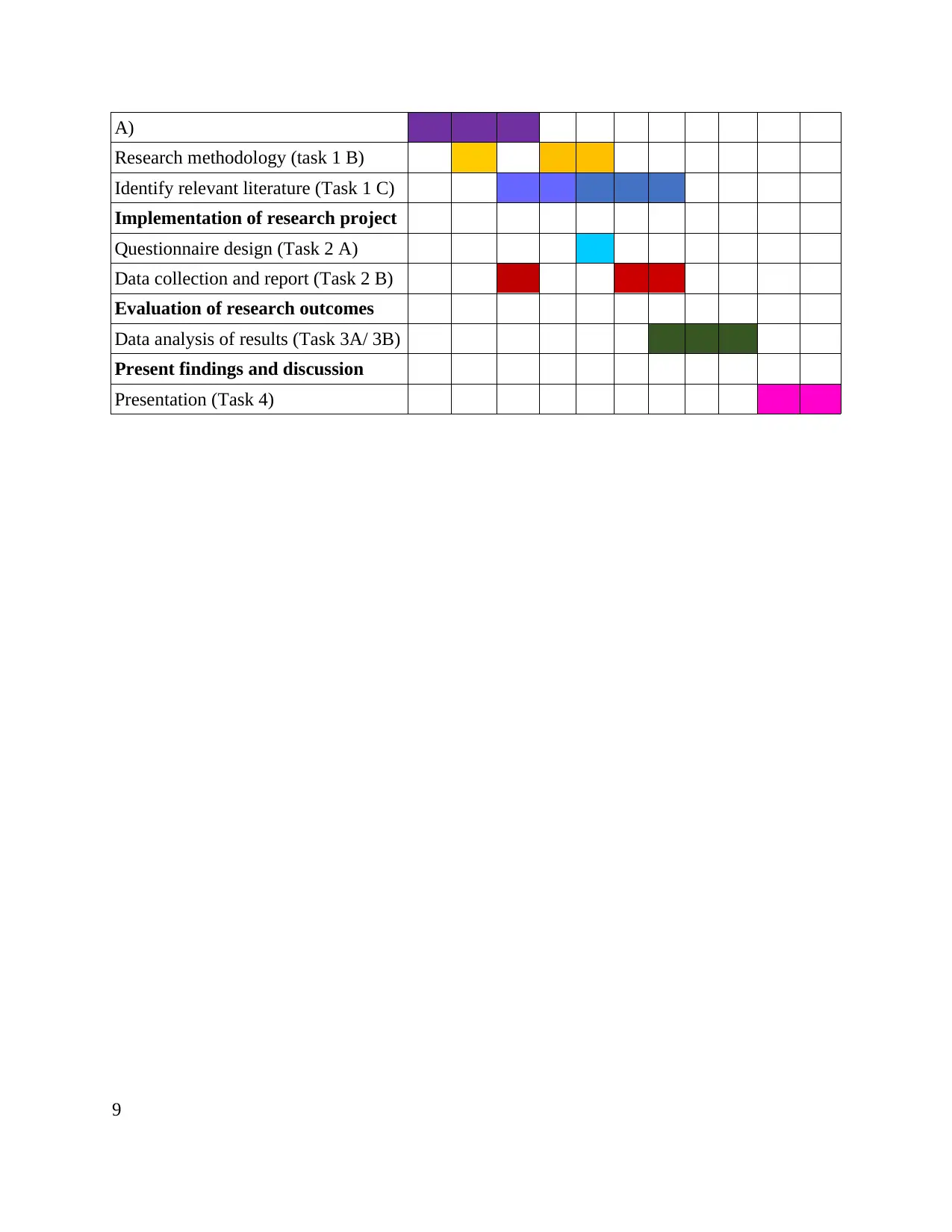
A)
Research methodology (task 1 B)
Identify relevant literature (Task 1 C)
Implementation of research project
Questionnaire design (Task 2 A)
Data collection and report (Task 2 B)
Evaluation of research outcomes
Data analysis of results (Task 3A/ 3B)
Present findings and discussion
Presentation (Task 4)
9
Research methodology (task 1 B)
Identify relevant literature (Task 1 C)
Implementation of research project
Questionnaire design (Task 2 A)
Data collection and report (Task 2 B)
Evaluation of research outcomes
Data analysis of results (Task 3A/ 3B)
Present findings and discussion
Presentation (Task 4)
9
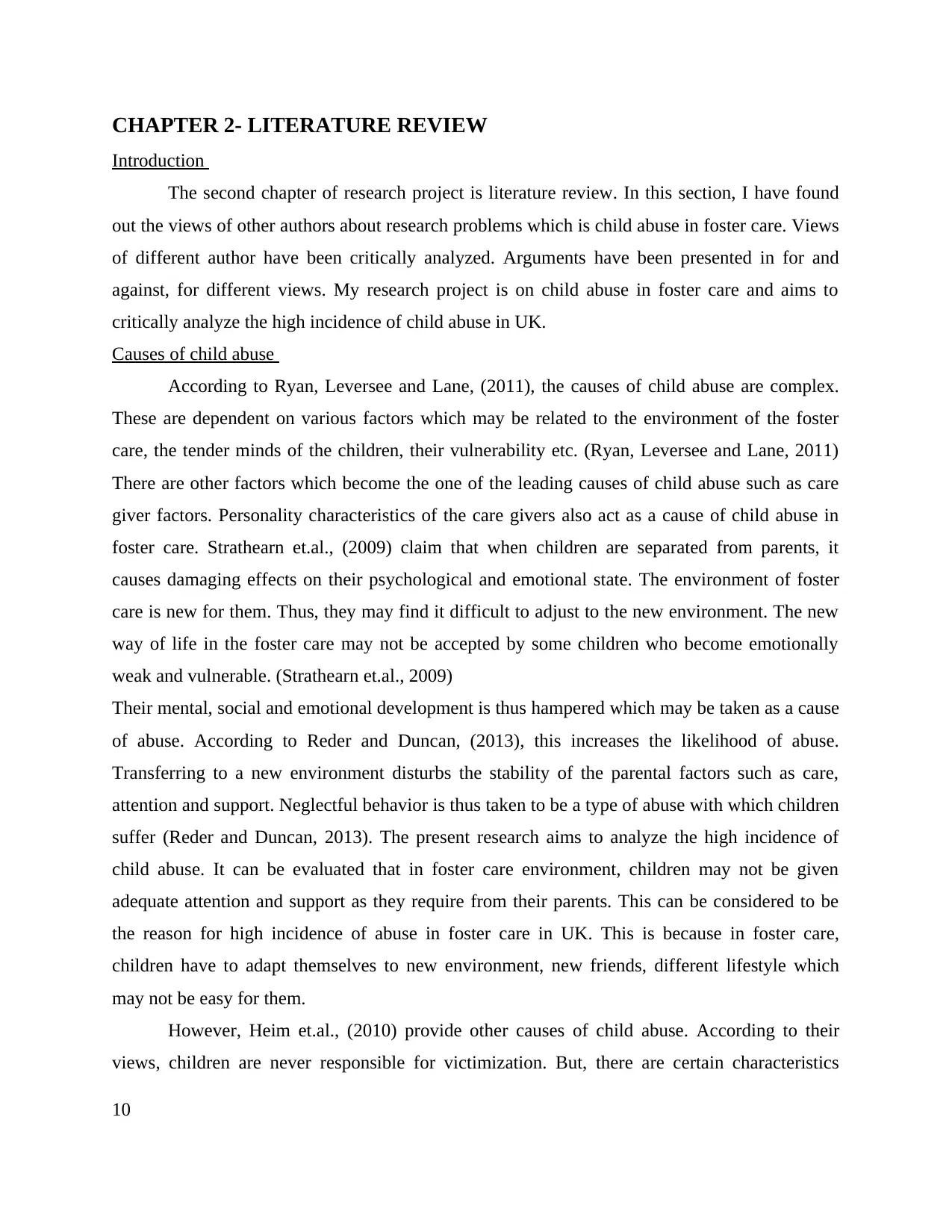
CHAPTER 2- LITERATURE REVIEW
Introduction
The second chapter of research project is literature review. In this section, I have found
out the views of other authors about research problems which is child abuse in foster care. Views
of different author have been critically analyzed. Arguments have been presented in for and
against, for different views. My research project is on child abuse in foster care and aims to
critically analyze the high incidence of child abuse in UK.
Causes of child abuse
According to Ryan, Leversee and Lane, (2011), the causes of child abuse are complex.
These are dependent on various factors which may be related to the environment of the foster
care, the tender minds of the children, their vulnerability etc. (Ryan, Leversee and Lane, 2011)
There are other factors which become the one of the leading causes of child abuse such as care
giver factors. Personality characteristics of the care givers also act as a cause of child abuse in
foster care. Strathearn et.al., (2009) claim that when children are separated from parents, it
causes damaging effects on their psychological and emotional state. The environment of foster
care is new for them. Thus, they may find it difficult to adjust to the new environment. The new
way of life in the foster care may not be accepted by some children who become emotionally
weak and vulnerable. (Strathearn et.al., 2009)
Their mental, social and emotional development is thus hampered which may be taken as a cause
of abuse. According to Reder and Duncan, (2013), this increases the likelihood of abuse.
Transferring to a new environment disturbs the stability of the parental factors such as care,
attention and support. Neglectful behavior is thus taken to be a type of abuse with which children
suffer (Reder and Duncan, 2013). The present research aims to analyze the high incidence of
child abuse. It can be evaluated that in foster care environment, children may not be given
adequate attention and support as they require from their parents. This can be considered to be
the reason for high incidence of abuse in foster care in UK. This is because in foster care,
children have to adapt themselves to new environment, new friends, different lifestyle which
may not be easy for them.
However, Heim et.al., (2010) provide other causes of child abuse. According to their
views, children are never responsible for victimization. But, there are certain characteristics
10
Introduction
The second chapter of research project is literature review. In this section, I have found
out the views of other authors about research problems which is child abuse in foster care. Views
of different author have been critically analyzed. Arguments have been presented in for and
against, for different views. My research project is on child abuse in foster care and aims to
critically analyze the high incidence of child abuse in UK.
Causes of child abuse
According to Ryan, Leversee and Lane, (2011), the causes of child abuse are complex.
These are dependent on various factors which may be related to the environment of the foster
care, the tender minds of the children, their vulnerability etc. (Ryan, Leversee and Lane, 2011)
There are other factors which become the one of the leading causes of child abuse such as care
giver factors. Personality characteristics of the care givers also act as a cause of child abuse in
foster care. Strathearn et.al., (2009) claim that when children are separated from parents, it
causes damaging effects on their psychological and emotional state. The environment of foster
care is new for them. Thus, they may find it difficult to adjust to the new environment. The new
way of life in the foster care may not be accepted by some children who become emotionally
weak and vulnerable. (Strathearn et.al., 2009)
Their mental, social and emotional development is thus hampered which may be taken as a cause
of abuse. According to Reder and Duncan, (2013), this increases the likelihood of abuse.
Transferring to a new environment disturbs the stability of the parental factors such as care,
attention and support. Neglectful behavior is thus taken to be a type of abuse with which children
suffer (Reder and Duncan, 2013). The present research aims to analyze the high incidence of
child abuse. It can be evaluated that in foster care environment, children may not be given
adequate attention and support as they require from their parents. This can be considered to be
the reason for high incidence of abuse in foster care in UK. This is because in foster care,
children have to adapt themselves to new environment, new friends, different lifestyle which
may not be easy for them.
However, Heim et.al., (2010) provide other causes of child abuse. According to their
views, children are never responsible for victimization. But, there are certain characteristics
10
Secure Best Marks with AI Grader
Need help grading? Try our AI Grader for instant feedback on your assignments.
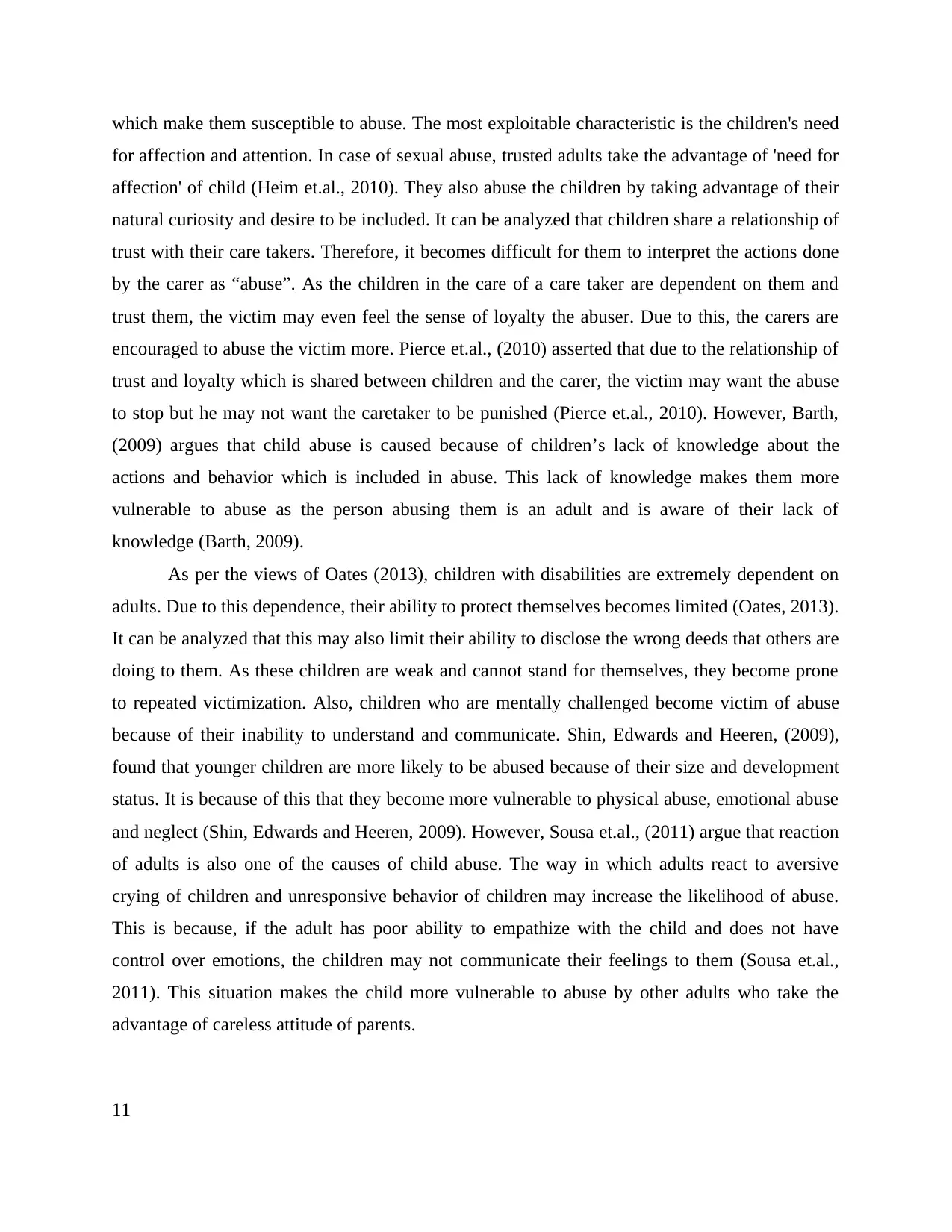
which make them susceptible to abuse. The most exploitable characteristic is the children's need
for affection and attention. In case of sexual abuse, trusted adults take the advantage of 'need for
affection' of child (Heim et.al., 2010). They also abuse the children by taking advantage of their
natural curiosity and desire to be included. It can be analyzed that children share a relationship of
trust with their care takers. Therefore, it becomes difficult for them to interpret the actions done
by the carer as “abuse”. As the children in the care of a care taker are dependent on them and
trust them, the victim may even feel the sense of loyalty the abuser. Due to this, the carers are
encouraged to abuse the victim more. Pierce et.al., (2010) asserted that due to the relationship of
trust and loyalty which is shared between children and the carer, the victim may want the abuse
to stop but he may not want the caretaker to be punished (Pierce et.al., 2010). However, Barth,
(2009) argues that child abuse is caused because of children’s lack of knowledge about the
actions and behavior which is included in abuse. This lack of knowledge makes them more
vulnerable to abuse as the person abusing them is an adult and is aware of their lack of
knowledge (Barth, 2009).
As per the views of Oates (2013), children with disabilities are extremely dependent on
adults. Due to this dependence, their ability to protect themselves becomes limited (Oates, 2013).
It can be analyzed that this may also limit their ability to disclose the wrong deeds that others are
doing to them. As these children are weak and cannot stand for themselves, they become prone
to repeated victimization. Also, children who are mentally challenged become victim of abuse
because of their inability to understand and communicate. Shin, Edwards and Heeren, (2009),
found that younger children are more likely to be abused because of their size and development
status. It is because of this that they become more vulnerable to physical abuse, emotional abuse
and neglect (Shin, Edwards and Heeren, 2009). However, Sousa et.al., (2011) argue that reaction
of adults is also one of the causes of child abuse. The way in which adults react to aversive
crying of children and unresponsive behavior of children may increase the likelihood of abuse.
This is because, if the adult has poor ability to empathize with the child and does not have
control over emotions, the children may not communicate their feelings to them (Sousa et.al.,
2011). This situation makes the child more vulnerable to abuse by other adults who take the
advantage of careless attitude of parents.
11
for affection and attention. In case of sexual abuse, trusted adults take the advantage of 'need for
affection' of child (Heim et.al., 2010). They also abuse the children by taking advantage of their
natural curiosity and desire to be included. It can be analyzed that children share a relationship of
trust with their care takers. Therefore, it becomes difficult for them to interpret the actions done
by the carer as “abuse”. As the children in the care of a care taker are dependent on them and
trust them, the victim may even feel the sense of loyalty the abuser. Due to this, the carers are
encouraged to abuse the victim more. Pierce et.al., (2010) asserted that due to the relationship of
trust and loyalty which is shared between children and the carer, the victim may want the abuse
to stop but he may not want the caretaker to be punished (Pierce et.al., 2010). However, Barth,
(2009) argues that child abuse is caused because of children’s lack of knowledge about the
actions and behavior which is included in abuse. This lack of knowledge makes them more
vulnerable to abuse as the person abusing them is an adult and is aware of their lack of
knowledge (Barth, 2009).
As per the views of Oates (2013), children with disabilities are extremely dependent on
adults. Due to this dependence, their ability to protect themselves becomes limited (Oates, 2013).
It can be analyzed that this may also limit their ability to disclose the wrong deeds that others are
doing to them. As these children are weak and cannot stand for themselves, they become prone
to repeated victimization. Also, children who are mentally challenged become victim of abuse
because of their inability to understand and communicate. Shin, Edwards and Heeren, (2009),
found that younger children are more likely to be abused because of their size and development
status. It is because of this that they become more vulnerable to physical abuse, emotional abuse
and neglect (Shin, Edwards and Heeren, 2009). However, Sousa et.al., (2011) argue that reaction
of adults is also one of the causes of child abuse. The way in which adults react to aversive
crying of children and unresponsive behavior of children may increase the likelihood of abuse.
This is because, if the adult has poor ability to empathize with the child and does not have
control over emotions, the children may not communicate their feelings to them (Sousa et.al.,
2011). This situation makes the child more vulnerable to abuse by other adults who take the
advantage of careless attitude of parents.
11

According to Hoff and Mitchell, (2009), certain 'caregiver factors' are also associated
with abuse. These include personality characteristics, psychological well-being, history of abuse
etc. care givers who have low self-esteem often abuse the children physically. Also, some carers
who have a history of child abuse and maltreatment in their childhood are likely to abuse the
children who are in their care (Hoff and Mitchell, 2009). Leatherman (2011) argues that lack of
knowledge and skills regarding child development are also some of the characteristics of abusive
caretakers. Some carers who lack parenting skills overuse physical punishment. Sometimes,
carers have difficulty in coping and self-control and possess general deficiency of interpersonal
skills. Those caretakers are likely to demonstrate abusive behavior (Leatherman, 2011).
Impact of child abuse in foster care on the Health and Social Care
As per the estimate of NSPCC, more than half million children suffer from abuse every
year. Child abuse has profound impacts on the entire life of children (Dugan, 2014). According
to Neigh, Gillespie and Nemeroff, (2009), the effects appear in childhood, adolescence,
adulthood and affect various spheres of the development of individual. When children are
maltreated, there is a higher risk of development of certain problems in children. Physical and
sexual abuse may lead to several negative health and physical effects (Neigh, Gillespie and
Nemeroff, 2009). These may be in the form of bruises, lacerations, broken bones, burns etc.
Physical trauma results in negative effects on physical development. Shaking an infant causes
bleeding and swelling in the pain thus exposing the child severe pain and other problems.
Kimbrough et.al., (2010) found that infants who have been neglected and malnourished
suffer from condition which is called as 'Non organic failure to thrive'. This leads to fall in the
weight, height and motor development of a child (Kimbrough et.al., 2010).
According to AUTHOPRS, children who have been abused in any form suffer from physical,
cognitive, social and emotional difficulties. Chronic physical, sexual and emotional abuse makes
the brain of child 'Wired' and he experiences the world as hostile and uncaring. This negative
perspective has impact on the later interactions of child and makes him overly aggressive or
withdrawn. Begle, Dumas and Hanson, (2010) found that child abuse inhibits the development of
certain regions of brain. Also the child shows problems in controlling his or her emotions. He
may also face problems in interacting properly with people around him or her. The present
12
with abuse. These include personality characteristics, psychological well-being, history of abuse
etc. care givers who have low self-esteem often abuse the children physically. Also, some carers
who have a history of child abuse and maltreatment in their childhood are likely to abuse the
children who are in their care (Hoff and Mitchell, 2009). Leatherman (2011) argues that lack of
knowledge and skills regarding child development are also some of the characteristics of abusive
caretakers. Some carers who lack parenting skills overuse physical punishment. Sometimes,
carers have difficulty in coping and self-control and possess general deficiency of interpersonal
skills. Those caretakers are likely to demonstrate abusive behavior (Leatherman, 2011).
Impact of child abuse in foster care on the Health and Social Care
As per the estimate of NSPCC, more than half million children suffer from abuse every
year. Child abuse has profound impacts on the entire life of children (Dugan, 2014). According
to Neigh, Gillespie and Nemeroff, (2009), the effects appear in childhood, adolescence,
adulthood and affect various spheres of the development of individual. When children are
maltreated, there is a higher risk of development of certain problems in children. Physical and
sexual abuse may lead to several negative health and physical effects (Neigh, Gillespie and
Nemeroff, 2009). These may be in the form of bruises, lacerations, broken bones, burns etc.
Physical trauma results in negative effects on physical development. Shaking an infant causes
bleeding and swelling in the pain thus exposing the child severe pain and other problems.
Kimbrough et.al., (2010) found that infants who have been neglected and malnourished
suffer from condition which is called as 'Non organic failure to thrive'. This leads to fall in the
weight, height and motor development of a child (Kimbrough et.al., 2010).
According to AUTHOPRS, children who have been abused in any form suffer from physical,
cognitive, social and emotional difficulties. Chronic physical, sexual and emotional abuse makes
the brain of child 'Wired' and he experiences the world as hostile and uncaring. This negative
perspective has impact on the later interactions of child and makes him overly aggressive or
withdrawn. Begle, Dumas and Hanson, (2010) found that child abuse inhibits the development of
certain regions of brain. Also the child shows problems in controlling his or her emotions. He
may also face problems in interacting properly with people around him or her. The present
12
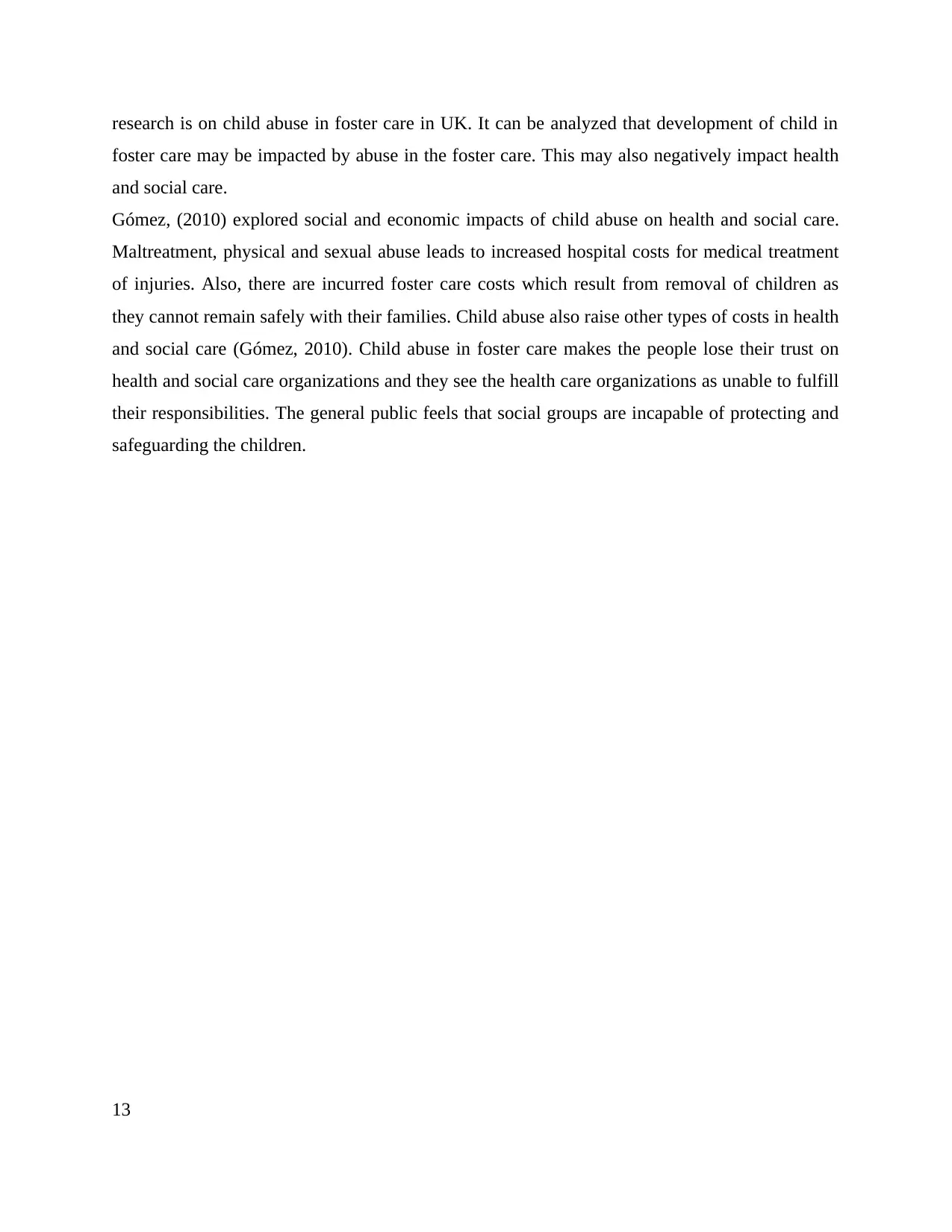
research is on child abuse in foster care in UK. It can be analyzed that development of child in
foster care may be impacted by abuse in the foster care. This may also negatively impact health
and social care.
Gómez, (2010) explored social and economic impacts of child abuse on health and social care.
Maltreatment, physical and sexual abuse leads to increased hospital costs for medical treatment
of injuries. Also, there are incurred foster care costs which result from removal of children as
they cannot remain safely with their families. Child abuse also raise other types of costs in health
and social care (Gómez, 2010). Child abuse in foster care makes the people lose their trust on
health and social care organizations and they see the health care organizations as unable to fulfill
their responsibilities. The general public feels that social groups are incapable of protecting and
safeguarding the children.
13
foster care may be impacted by abuse in the foster care. This may also negatively impact health
and social care.
Gómez, (2010) explored social and economic impacts of child abuse on health and social care.
Maltreatment, physical and sexual abuse leads to increased hospital costs for medical treatment
of injuries. Also, there are incurred foster care costs which result from removal of children as
they cannot remain safely with their families. Child abuse also raise other types of costs in health
and social care (Gómez, 2010). Child abuse in foster care makes the people lose their trust on
health and social care organizations and they see the health care organizations as unable to fulfill
their responsibilities. The general public feels that social groups are incapable of protecting and
safeguarding the children.
13
Paraphrase This Document
Need a fresh take? Get an instant paraphrase of this document with our AI Paraphraser
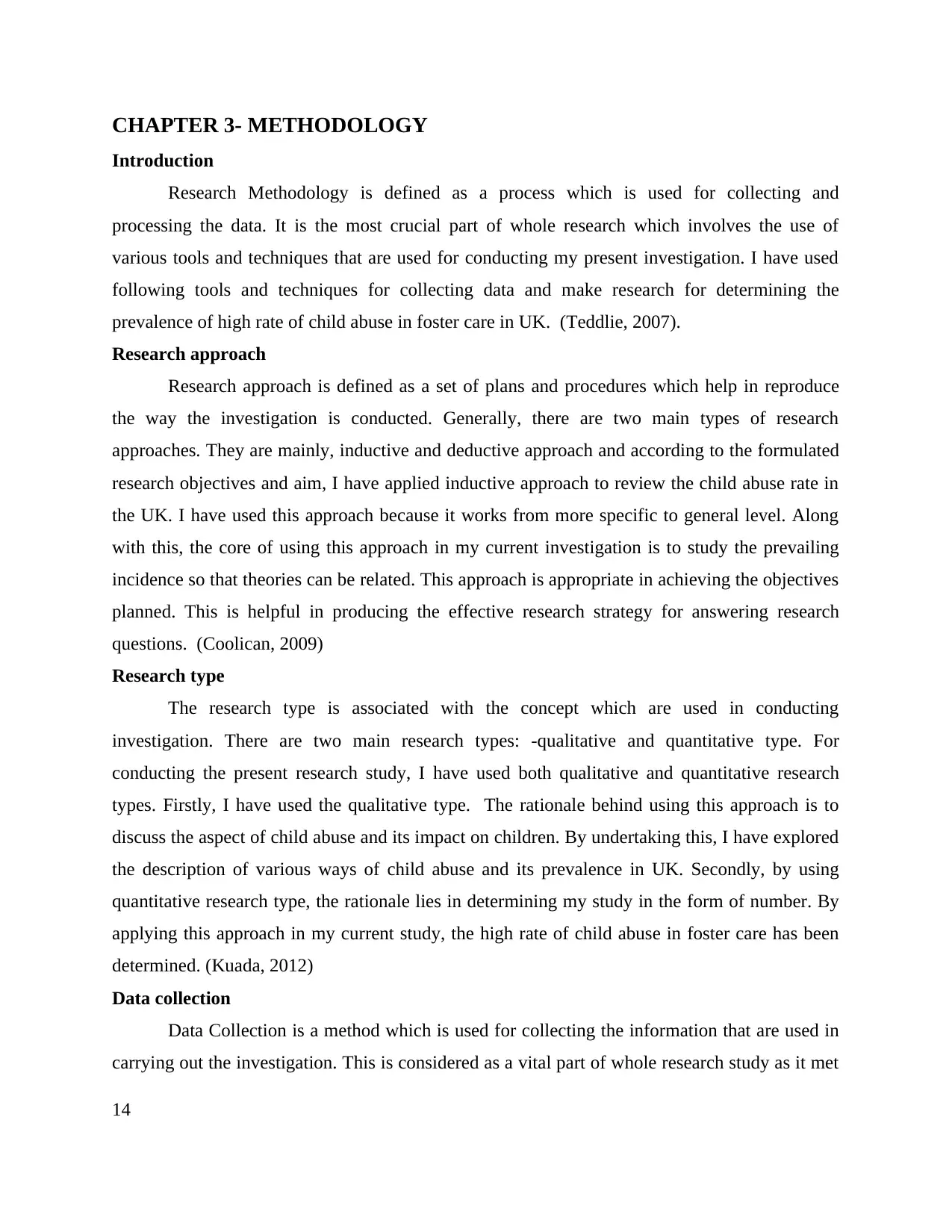
CHAPTER 3- METHODOLOGY
Introduction
Research Methodology is defined as a process which is used for collecting and
processing the data. It is the most crucial part of whole research which involves the use of
various tools and techniques that are used for conducting my present investigation. I have used
following tools and techniques for collecting data and make research for determining the
prevalence of high rate of child abuse in foster care in UK. (Teddlie, 2007).
Research approach
Research approach is defined as a set of plans and procedures which help in reproduce
the way the investigation is conducted. Generally, there are two main types of research
approaches. They are mainly, inductive and deductive approach and according to the formulated
research objectives and aim, I have applied inductive approach to review the child abuse rate in
the UK. I have used this approach because it works from more specific to general level. Along
with this, the core of using this approach in my current investigation is to study the prevailing
incidence so that theories can be related. This approach is appropriate in achieving the objectives
planned. This is helpful in producing the effective research strategy for answering research
questions. (Coolican, 2009)
Research type
The research type is associated with the concept which are used in conducting
investigation. There are two main research types: -qualitative and quantitative type. For
conducting the present research study, I have used both qualitative and quantitative research
types. Firstly, I have used the qualitative type. The rationale behind using this approach is to
discuss the aspect of child abuse and its impact on children. By undertaking this, I have explored
the description of various ways of child abuse and its prevalence in UK. Secondly, by using
quantitative research type, the rationale lies in determining my study in the form of number. By
applying this approach in my current study, the high rate of child abuse in foster care has been
determined. (Kuada, 2012)
Data collection
Data Collection is a method which is used for collecting the information that are used in
carrying out the investigation. This is considered as a vital part of whole research study as it met
14
Introduction
Research Methodology is defined as a process which is used for collecting and
processing the data. It is the most crucial part of whole research which involves the use of
various tools and techniques that are used for conducting my present investigation. I have used
following tools and techniques for collecting data and make research for determining the
prevalence of high rate of child abuse in foster care in UK. (Teddlie, 2007).
Research approach
Research approach is defined as a set of plans and procedures which help in reproduce
the way the investigation is conducted. Generally, there are two main types of research
approaches. They are mainly, inductive and deductive approach and according to the formulated
research objectives and aim, I have applied inductive approach to review the child abuse rate in
the UK. I have used this approach because it works from more specific to general level. Along
with this, the core of using this approach in my current investigation is to study the prevailing
incidence so that theories can be related. This approach is appropriate in achieving the objectives
planned. This is helpful in producing the effective research strategy for answering research
questions. (Coolican, 2009)
Research type
The research type is associated with the concept which are used in conducting
investigation. There are two main research types: -qualitative and quantitative type. For
conducting the present research study, I have used both qualitative and quantitative research
types. Firstly, I have used the qualitative type. The rationale behind using this approach is to
discuss the aspect of child abuse and its impact on children. By undertaking this, I have explored
the description of various ways of child abuse and its prevalence in UK. Secondly, by using
quantitative research type, the rationale lies in determining my study in the form of number. By
applying this approach in my current study, the high rate of child abuse in foster care has been
determined. (Kuada, 2012)
Data collection
Data Collection is a method which is used for collecting the information that are used in
carrying out the investigation. This is considered as a vital part of whole research study as it met
14
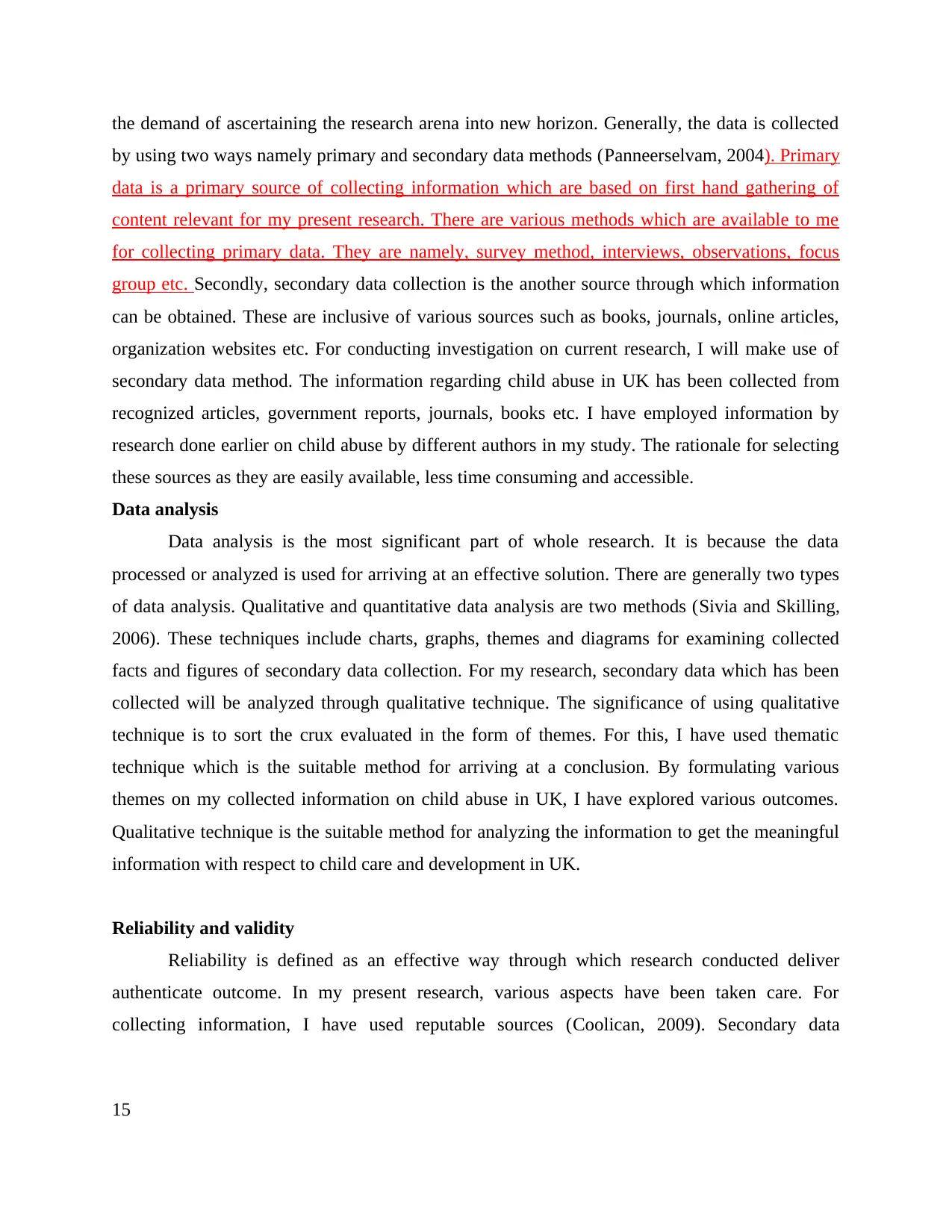
the demand of ascertaining the research arena into new horizon. Generally, the data is collected
by using two ways namely primary and secondary data methods (Panneerselvam, 2004). Primary
data is a primary source of collecting information which are based on first hand gathering of
content relevant for my present research. There are various methods which are available to me
for collecting primary data. They are namely, survey method, interviews, observations, focus
group etc. Secondly, secondary data collection is the another source through which information
can be obtained. These are inclusive of various sources such as books, journals, online articles,
organization websites etc. For conducting investigation on current research, I will make use of
secondary data method. The information regarding child abuse in UK has been collected from
recognized articles, government reports, journals, books etc. I have employed information by
research done earlier on child abuse by different authors in my study. The rationale for selecting
these sources as they are easily available, less time consuming and accessible.
Data analysis
Data analysis is the most significant part of whole research. It is because the data
processed or analyzed is used for arriving at an effective solution. There are generally two types
of data analysis. Qualitative and quantitative data analysis are two methods (Sivia and Skilling,
2006). These techniques include charts, graphs, themes and diagrams for examining collected
facts and figures of secondary data collection. For my research, secondary data which has been
collected will be analyzed through qualitative technique. The significance of using qualitative
technique is to sort the crux evaluated in the form of themes. For this, I have used thematic
technique which is the suitable method for arriving at a conclusion. By formulating various
themes on my collected information on child abuse in UK, I have explored various outcomes.
Qualitative technique is the suitable method for analyzing the information to get the meaningful
information with respect to child care and development in UK.
Reliability and validity
Reliability is defined as an effective way through which research conducted deliver
authenticate outcome. In my present research, various aspects have been taken care. For
collecting information, I have used reputable sources (Coolican, 2009). Secondary data
15
by using two ways namely primary and secondary data methods (Panneerselvam, 2004). Primary
data is a primary source of collecting information which are based on first hand gathering of
content relevant for my present research. There are various methods which are available to me
for collecting primary data. They are namely, survey method, interviews, observations, focus
group etc. Secondly, secondary data collection is the another source through which information
can be obtained. These are inclusive of various sources such as books, journals, online articles,
organization websites etc. For conducting investigation on current research, I will make use of
secondary data method. The information regarding child abuse in UK has been collected from
recognized articles, government reports, journals, books etc. I have employed information by
research done earlier on child abuse by different authors in my study. The rationale for selecting
these sources as they are easily available, less time consuming and accessible.
Data analysis
Data analysis is the most significant part of whole research. It is because the data
processed or analyzed is used for arriving at an effective solution. There are generally two types
of data analysis. Qualitative and quantitative data analysis are two methods (Sivia and Skilling,
2006). These techniques include charts, graphs, themes and diagrams for examining collected
facts and figures of secondary data collection. For my research, secondary data which has been
collected will be analyzed through qualitative technique. The significance of using qualitative
technique is to sort the crux evaluated in the form of themes. For this, I have used thematic
technique which is the suitable method for arriving at a conclusion. By formulating various
themes on my collected information on child abuse in UK, I have explored various outcomes.
Qualitative technique is the suitable method for analyzing the information to get the meaningful
information with respect to child care and development in UK.
Reliability and validity
Reliability is defined as an effective way through which research conducted deliver
authenticate outcome. In my present research, various aspects have been taken care. For
collecting information, I have used reputable sources (Coolican, 2009). Secondary data
15
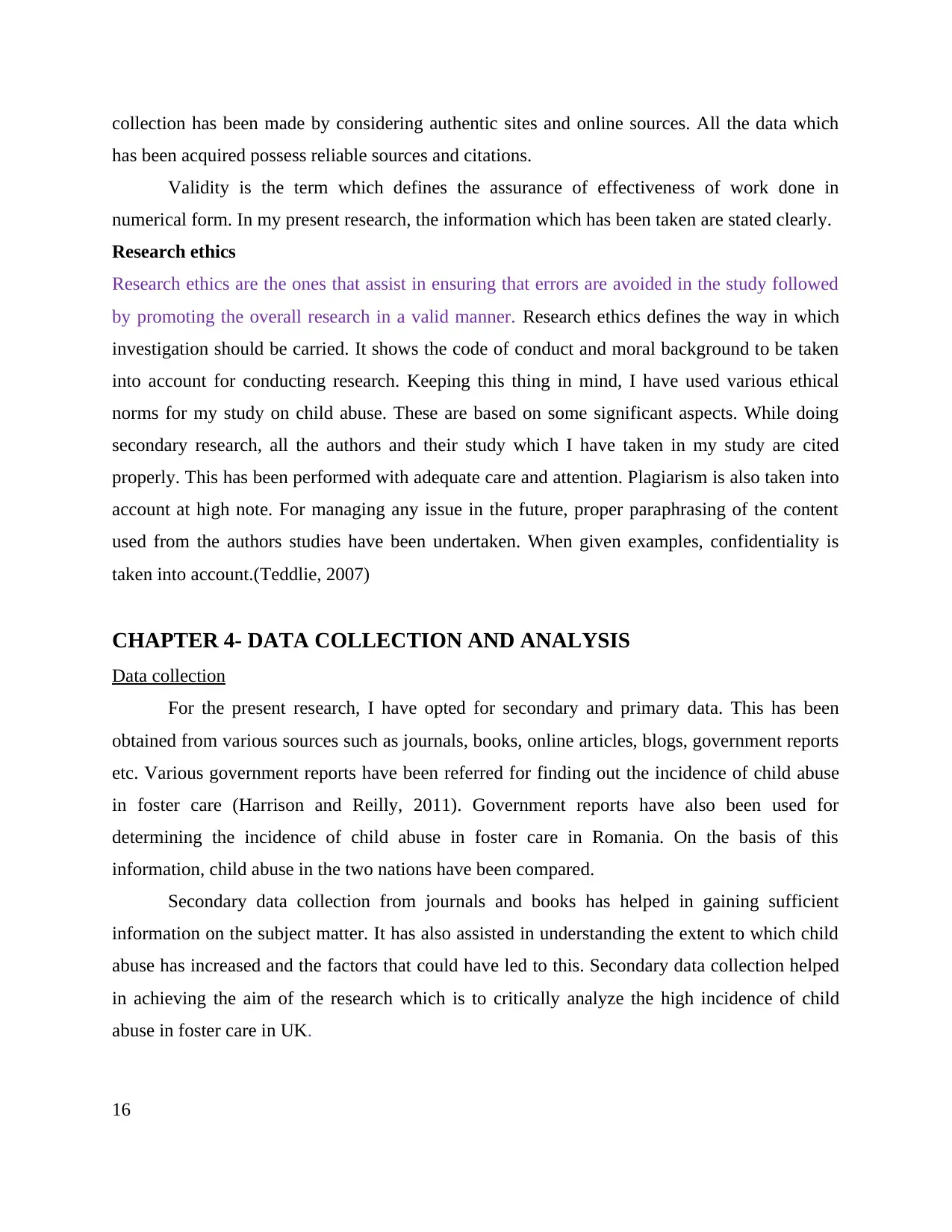
collection has been made by considering authentic sites and online sources. All the data which
has been acquired possess reliable sources and citations.
Validity is the term which defines the assurance of effectiveness of work done in
numerical form. In my present research, the information which has been taken are stated clearly.
Research ethics
Research ethics are the ones that assist in ensuring that errors are avoided in the study followed
by promoting the overall research in a valid manner. Research ethics defines the way in which
investigation should be carried. It shows the code of conduct and moral background to be taken
into account for conducting research. Keeping this thing in mind, I have used various ethical
norms for my study on child abuse. These are based on some significant aspects. While doing
secondary research, all the authors and their study which I have taken in my study are cited
properly. This has been performed with adequate care and attention. Plagiarism is also taken into
account at high note. For managing any issue in the future, proper paraphrasing of the content
used from the authors studies have been undertaken. When given examples, confidentiality is
taken into account.(Teddlie, 2007)
CHAPTER 4- DATA COLLECTION AND ANALYSIS
Data collection
For the present research, I have opted for secondary and primary data. This has been
obtained from various sources such as journals, books, online articles, blogs, government reports
etc. Various government reports have been referred for finding out the incidence of child abuse
in foster care (Harrison and Reilly, 2011). Government reports have also been used for
determining the incidence of child abuse in foster care in Romania. On the basis of this
information, child abuse in the two nations have been compared.
Secondary data collection from journals and books has helped in gaining sufficient
information on the subject matter. It has also assisted in understanding the extent to which child
abuse has increased and the factors that could have led to this. Secondary data collection helped
in achieving the aim of the research which is to critically analyze the high incidence of child
abuse in foster care in UK.
16
has been acquired possess reliable sources and citations.
Validity is the term which defines the assurance of effectiveness of work done in
numerical form. In my present research, the information which has been taken are stated clearly.
Research ethics
Research ethics are the ones that assist in ensuring that errors are avoided in the study followed
by promoting the overall research in a valid manner. Research ethics defines the way in which
investigation should be carried. It shows the code of conduct and moral background to be taken
into account for conducting research. Keeping this thing in mind, I have used various ethical
norms for my study on child abuse. These are based on some significant aspects. While doing
secondary research, all the authors and their study which I have taken in my study are cited
properly. This has been performed with adequate care and attention. Plagiarism is also taken into
account at high note. For managing any issue in the future, proper paraphrasing of the content
used from the authors studies have been undertaken. When given examples, confidentiality is
taken into account.(Teddlie, 2007)
CHAPTER 4- DATA COLLECTION AND ANALYSIS
Data collection
For the present research, I have opted for secondary and primary data. This has been
obtained from various sources such as journals, books, online articles, blogs, government reports
etc. Various government reports have been referred for finding out the incidence of child abuse
in foster care (Harrison and Reilly, 2011). Government reports have also been used for
determining the incidence of child abuse in foster care in Romania. On the basis of this
information, child abuse in the two nations have been compared.
Secondary data collection from journals and books has helped in gaining sufficient
information on the subject matter. It has also assisted in understanding the extent to which child
abuse has increased and the factors that could have led to this. Secondary data collection helped
in achieving the aim of the research which is to critically analyze the high incidence of child
abuse in foster care in UK.
16
Secure Best Marks with AI Grader
Need help grading? Try our AI Grader for instant feedback on your assignments.
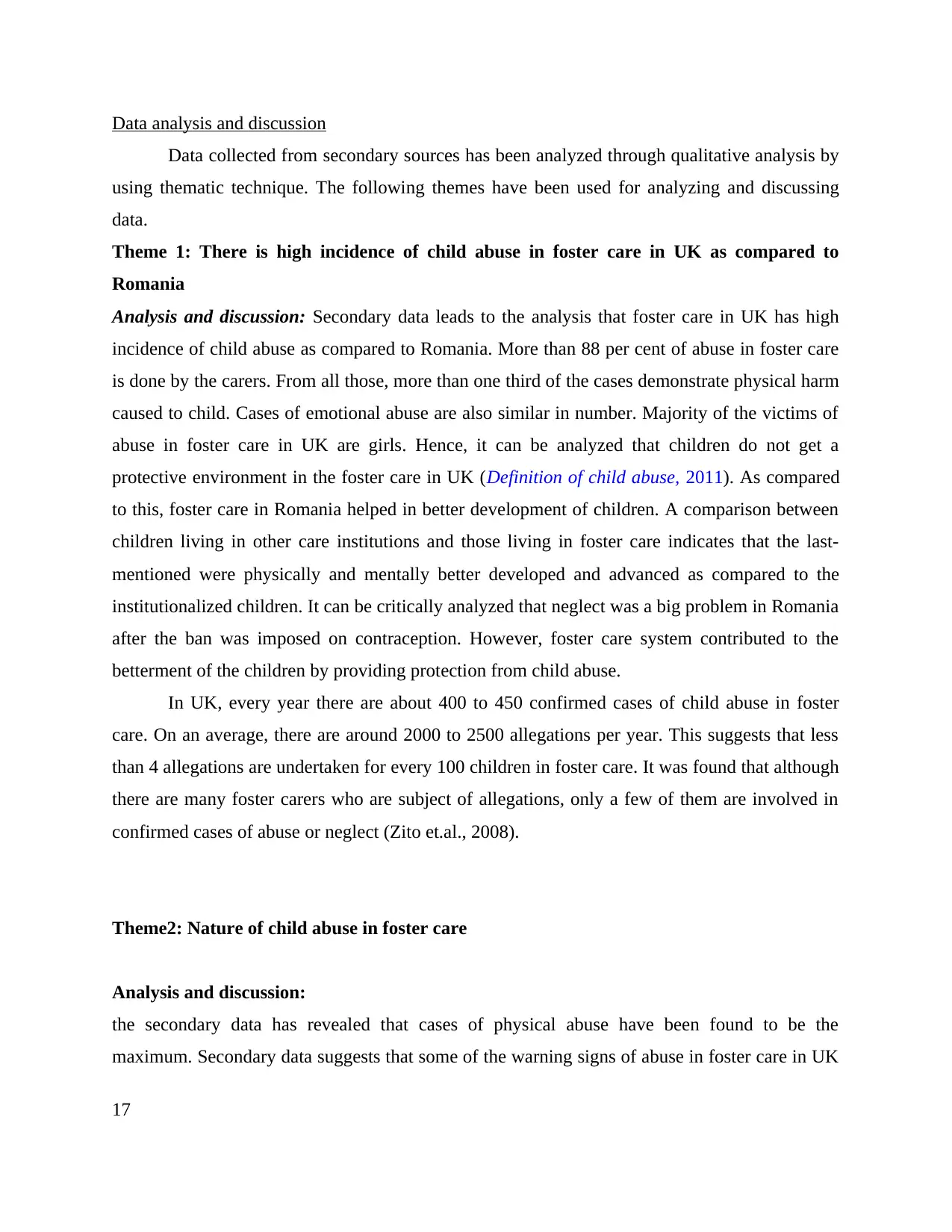
Data analysis and discussion
Data collected from secondary sources has been analyzed through qualitative analysis by
using thematic technique. The following themes have been used for analyzing and discussing
data.
Theme 1: There is high incidence of child abuse in foster care in UK as compared to
Romania
Analysis and discussion: Secondary data leads to the analysis that foster care in UK has high
incidence of child abuse as compared to Romania. More than 88 per cent of abuse in foster care
is done by the carers. From all those, more than one third of the cases demonstrate physical harm
caused to child. Cases of emotional abuse are also similar in number. Majority of the victims of
abuse in foster care in UK are girls. Hence, it can be analyzed that children do not get a
protective environment in the foster care in UK (Definition of child abuse, 2011). As compared
to this, foster care in Romania helped in better development of children. A comparison between
children living in other care institutions and those living in foster care indicates that the last-
mentioned were physically and mentally better developed and advanced as compared to the
institutionalized children. It can be critically analyzed that neglect was a big problem in Romania
after the ban was imposed on contraception. However, foster care system contributed to the
betterment of the children by providing protection from child abuse.
In UK, every year there are about 400 to 450 confirmed cases of child abuse in foster
care. On an average, there are around 2000 to 2500 allegations per year. This suggests that less
than 4 allegations are undertaken for every 100 children in foster care. It was found that although
there are many foster carers who are subject of allegations, only a few of them are involved in
confirmed cases of abuse or neglect (Zito et.al., 2008).
Theme2: Nature of child abuse in foster care
Analysis and discussion:
the secondary data has revealed that cases of physical abuse have been found to be the
maximum. Secondary data suggests that some of the warning signs of abuse in foster care in UK
17
Data collected from secondary sources has been analyzed through qualitative analysis by
using thematic technique. The following themes have been used for analyzing and discussing
data.
Theme 1: There is high incidence of child abuse in foster care in UK as compared to
Romania
Analysis and discussion: Secondary data leads to the analysis that foster care in UK has high
incidence of child abuse as compared to Romania. More than 88 per cent of abuse in foster care
is done by the carers. From all those, more than one third of the cases demonstrate physical harm
caused to child. Cases of emotional abuse are also similar in number. Majority of the victims of
abuse in foster care in UK are girls. Hence, it can be analyzed that children do not get a
protective environment in the foster care in UK (Definition of child abuse, 2011). As compared
to this, foster care in Romania helped in better development of children. A comparison between
children living in other care institutions and those living in foster care indicates that the last-
mentioned were physically and mentally better developed and advanced as compared to the
institutionalized children. It can be critically analyzed that neglect was a big problem in Romania
after the ban was imposed on contraception. However, foster care system contributed to the
betterment of the children by providing protection from child abuse.
In UK, every year there are about 400 to 450 confirmed cases of child abuse in foster
care. On an average, there are around 2000 to 2500 allegations per year. This suggests that less
than 4 allegations are undertaken for every 100 children in foster care. It was found that although
there are many foster carers who are subject of allegations, only a few of them are involved in
confirmed cases of abuse or neglect (Zito et.al., 2008).
Theme2: Nature of child abuse in foster care
Analysis and discussion:
the secondary data has revealed that cases of physical abuse have been found to be the
maximum. Secondary data suggests that some of the warning signs of abuse in foster care in UK
17
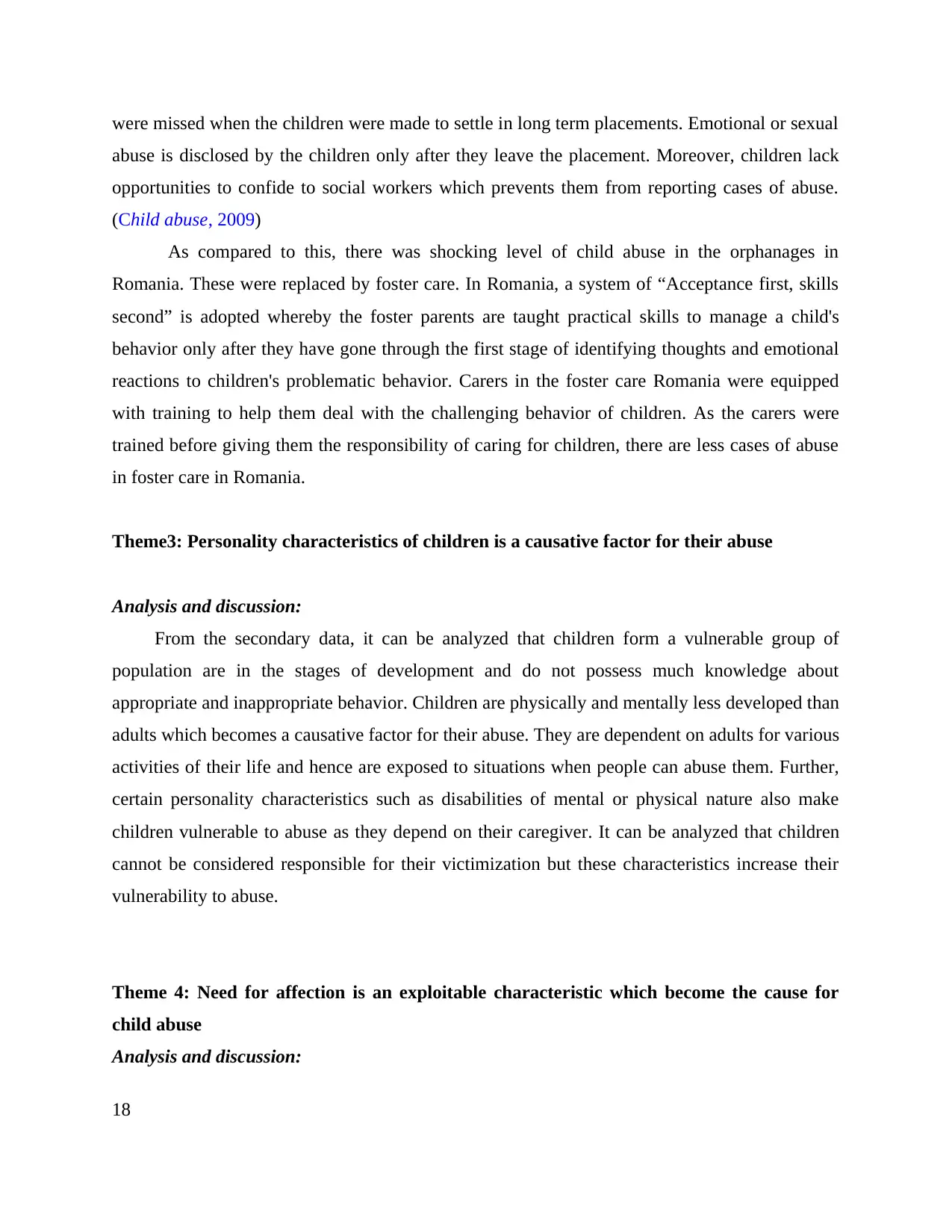
were missed when the children were made to settle in long term placements. Emotional or sexual
abuse is disclosed by the children only after they leave the placement. Moreover, children lack
opportunities to confide to social workers which prevents them from reporting cases of abuse.
(Child abuse, 2009)
As compared to this, there was shocking level of child abuse in the orphanages in
Romania. These were replaced by foster care. In Romania, a system of “Acceptance first, skills
second” is adopted whereby the foster parents are taught practical skills to manage a child's
behavior only after they have gone through the first stage of identifying thoughts and emotional
reactions to children's problematic behavior. Carers in the foster care Romania were equipped
with training to help them deal with the challenging behavior of children. As the carers were
trained before giving them the responsibility of caring for children, there are less cases of abuse
in foster care in Romania.
Theme3: Personality characteristics of children is a causative factor for their abuse
Analysis and discussion:
From the secondary data, it can be analyzed that children form a vulnerable group of
population are in the stages of development and do not possess much knowledge about
appropriate and inappropriate behavior. Children are physically and mentally less developed than
adults which becomes a causative factor for their abuse. They are dependent on adults for various
activities of their life and hence are exposed to situations when people can abuse them. Further,
certain personality characteristics such as disabilities of mental or physical nature also make
children vulnerable to abuse as they depend on their caregiver. It can be analyzed that children
cannot be considered responsible for their victimization but these characteristics increase their
vulnerability to abuse.
Theme 4: Need for affection is an exploitable characteristic which become the cause for
child abuse
Analysis and discussion:
18
abuse is disclosed by the children only after they leave the placement. Moreover, children lack
opportunities to confide to social workers which prevents them from reporting cases of abuse.
(Child abuse, 2009)
As compared to this, there was shocking level of child abuse in the orphanages in
Romania. These were replaced by foster care. In Romania, a system of “Acceptance first, skills
second” is adopted whereby the foster parents are taught practical skills to manage a child's
behavior only after they have gone through the first stage of identifying thoughts and emotional
reactions to children's problematic behavior. Carers in the foster care Romania were equipped
with training to help them deal with the challenging behavior of children. As the carers were
trained before giving them the responsibility of caring for children, there are less cases of abuse
in foster care in Romania.
Theme3: Personality characteristics of children is a causative factor for their abuse
Analysis and discussion:
From the secondary data, it can be analyzed that children form a vulnerable group of
population are in the stages of development and do not possess much knowledge about
appropriate and inappropriate behavior. Children are physically and mentally less developed than
adults which becomes a causative factor for their abuse. They are dependent on adults for various
activities of their life and hence are exposed to situations when people can abuse them. Further,
certain personality characteristics such as disabilities of mental or physical nature also make
children vulnerable to abuse as they depend on their caregiver. It can be analyzed that children
cannot be considered responsible for their victimization but these characteristics increase their
vulnerability to abuse.
Theme 4: Need for affection is an exploitable characteristic which become the cause for
child abuse
Analysis and discussion:
18
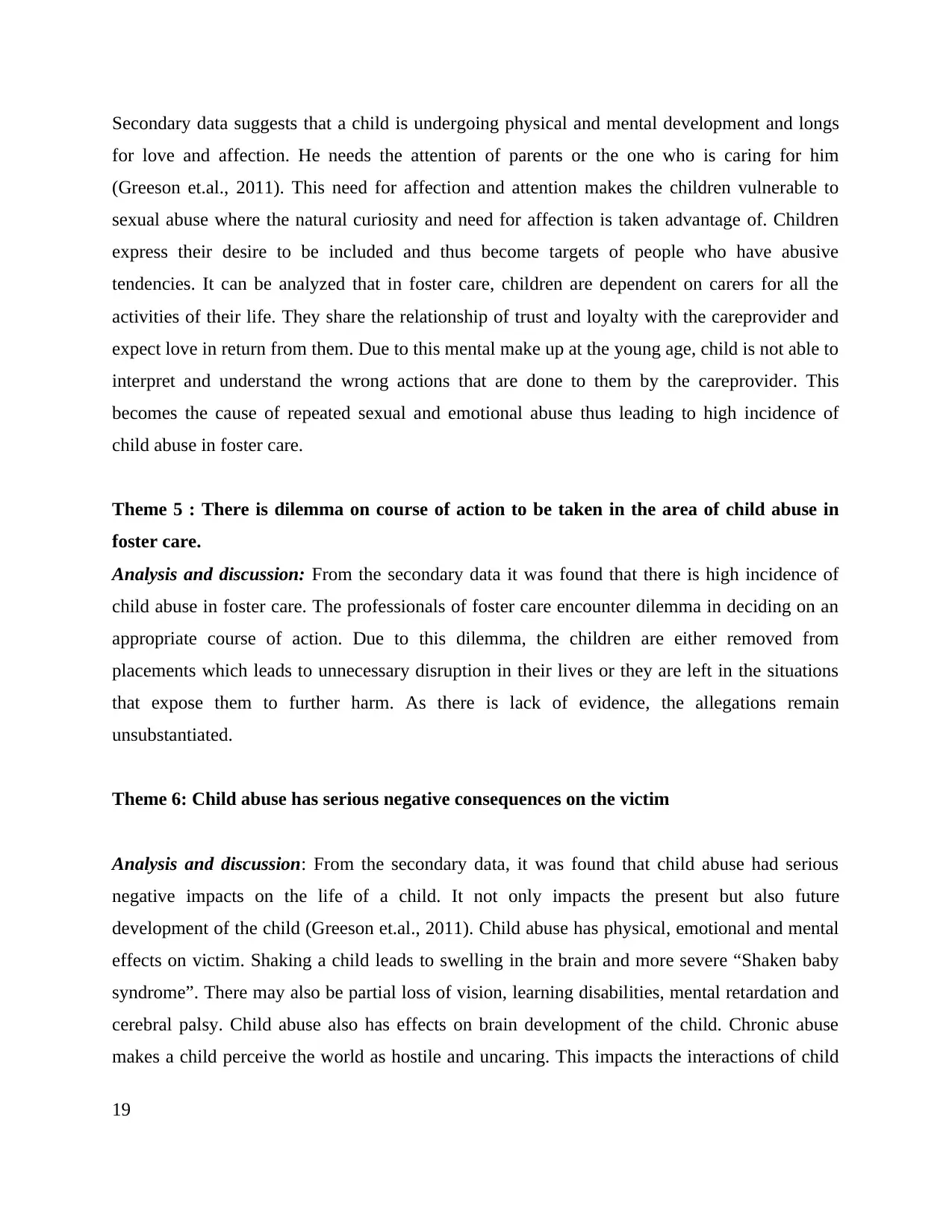
Secondary data suggests that a child is undergoing physical and mental development and longs
for love and affection. He needs the attention of parents or the one who is caring for him
(Greeson et.al., 2011). This need for affection and attention makes the children vulnerable to
sexual abuse where the natural curiosity and need for affection is taken advantage of. Children
express their desire to be included and thus become targets of people who have abusive
tendencies. It can be analyzed that in foster care, children are dependent on carers for all the
activities of their life. They share the relationship of trust and loyalty with the careprovider and
expect love in return from them. Due to this mental make up at the young age, child is not able to
interpret and understand the wrong actions that are done to them by the careprovider. This
becomes the cause of repeated sexual and emotional abuse thus leading to high incidence of
child abuse in foster care.
Theme 5 : There is dilemma on course of action to be taken in the area of child abuse in
foster care.
Analysis and discussion: From the secondary data it was found that there is high incidence of
child abuse in foster care. The professionals of foster care encounter dilemma in deciding on an
appropriate course of action. Due to this dilemma, the children are either removed from
placements which leads to unnecessary disruption in their lives or they are left in the situations
that expose them to further harm. As there is lack of evidence, the allegations remain
unsubstantiated.
Theme 6: Child abuse has serious negative consequences on the victim
Analysis and discussion: From the secondary data, it was found that child abuse had serious
negative impacts on the life of a child. It not only impacts the present but also future
development of the child (Greeson et.al., 2011). Child abuse has physical, emotional and mental
effects on victim. Shaking a child leads to swelling in the brain and more severe “Shaken baby
syndrome”. There may also be partial loss of vision, learning disabilities, mental retardation and
cerebral palsy. Child abuse also has effects on brain development of the child. Chronic abuse
makes a child perceive the world as hostile and uncaring. This impacts the interactions of child
19
for love and affection. He needs the attention of parents or the one who is caring for him
(Greeson et.al., 2011). This need for affection and attention makes the children vulnerable to
sexual abuse where the natural curiosity and need for affection is taken advantage of. Children
express their desire to be included and thus become targets of people who have abusive
tendencies. It can be analyzed that in foster care, children are dependent on carers for all the
activities of their life. They share the relationship of trust and loyalty with the careprovider and
expect love in return from them. Due to this mental make up at the young age, child is not able to
interpret and understand the wrong actions that are done to them by the careprovider. This
becomes the cause of repeated sexual and emotional abuse thus leading to high incidence of
child abuse in foster care.
Theme 5 : There is dilemma on course of action to be taken in the area of child abuse in
foster care.
Analysis and discussion: From the secondary data it was found that there is high incidence of
child abuse in foster care. The professionals of foster care encounter dilemma in deciding on an
appropriate course of action. Due to this dilemma, the children are either removed from
placements which leads to unnecessary disruption in their lives or they are left in the situations
that expose them to further harm. As there is lack of evidence, the allegations remain
unsubstantiated.
Theme 6: Child abuse has serious negative consequences on the victim
Analysis and discussion: From the secondary data, it was found that child abuse had serious
negative impacts on the life of a child. It not only impacts the present but also future
development of the child (Greeson et.al., 2011). Child abuse has physical, emotional and mental
effects on victim. Shaking a child leads to swelling in the brain and more severe “Shaken baby
syndrome”. There may also be partial loss of vision, learning disabilities, mental retardation and
cerebral palsy. Child abuse also has effects on brain development of the child. Chronic abuse
makes a child perceive the world as hostile and uncaring. This impacts the interactions of child
19
Paraphrase This Document
Need a fresh take? Get an instant paraphrase of this document with our AI Paraphraser
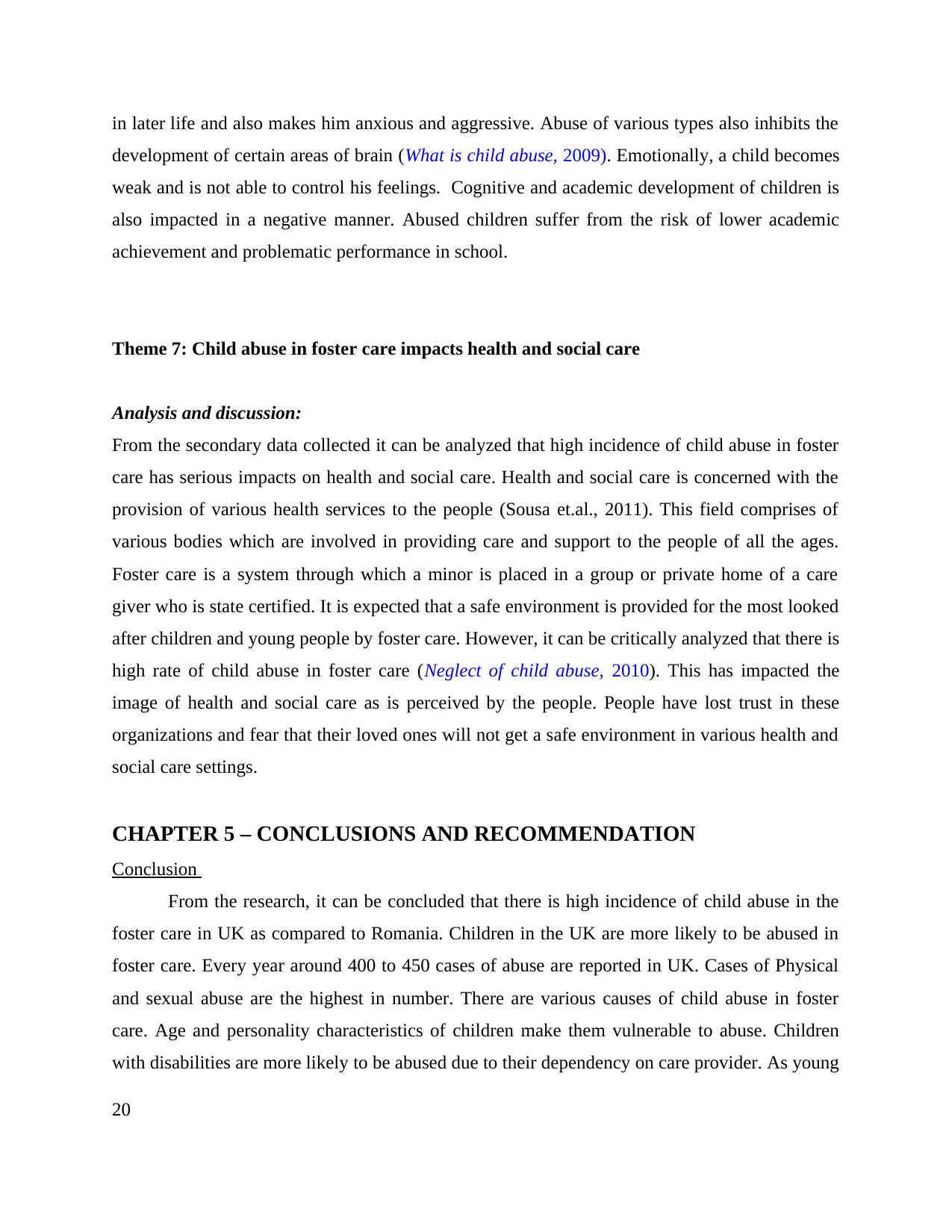
in later life and also makes him anxious and aggressive. Abuse of various types also inhibits the
development of certain areas of brain (What is child abuse, 2009). Emotionally, a child becomes
weak and is not able to control his feelings. Cognitive and academic development of children is
also impacted in a negative manner. Abused children suffer from the risk of lower academic
achievement and problematic performance in school.
Theme 7: Child abuse in foster care impacts health and social care
Analysis and discussion:
From the secondary data collected it can be analyzed that high incidence of child abuse in foster
care has serious impacts on health and social care. Health and social care is concerned with the
provision of various health services to the people (Sousa et.al., 2011). This field comprises of
various bodies which are involved in providing care and support to the people of all the ages.
Foster care is a system through which a minor is placed in a group or private home of a care
giver who is state certified. It is expected that a safe environment is provided for the most looked
after children and young people by foster care. However, it can be critically analyzed that there is
high rate of child abuse in foster care (Neglect of child abuse, 2010). This has impacted the
image of health and social care as is perceived by the people. People have lost trust in these
organizations and fear that their loved ones will not get a safe environment in various health and
social care settings.
CHAPTER 5 – CONCLUSIONS AND RECOMMENDATION
Conclusion
From the research, it can be concluded that there is high incidence of child abuse in the
foster care in UK as compared to Romania. Children in the UK are more likely to be abused in
foster care. Every year around 400 to 450 cases of abuse are reported in UK. Cases of Physical
and sexual abuse are the highest in number. There are various causes of child abuse in foster
care. Age and personality characteristics of children make them vulnerable to abuse. Children
with disabilities are more likely to be abused due to their dependency on care provider. As young
20
development of certain areas of brain (What is child abuse, 2009). Emotionally, a child becomes
weak and is not able to control his feelings. Cognitive and academic development of children is
also impacted in a negative manner. Abused children suffer from the risk of lower academic
achievement and problematic performance in school.
Theme 7: Child abuse in foster care impacts health and social care
Analysis and discussion:
From the secondary data collected it can be analyzed that high incidence of child abuse in foster
care has serious impacts on health and social care. Health and social care is concerned with the
provision of various health services to the people (Sousa et.al., 2011). This field comprises of
various bodies which are involved in providing care and support to the people of all the ages.
Foster care is a system through which a minor is placed in a group or private home of a care
giver who is state certified. It is expected that a safe environment is provided for the most looked
after children and young people by foster care. However, it can be critically analyzed that there is
high rate of child abuse in foster care (Neglect of child abuse, 2010). This has impacted the
image of health and social care as is perceived by the people. People have lost trust in these
organizations and fear that their loved ones will not get a safe environment in various health and
social care settings.
CHAPTER 5 – CONCLUSIONS AND RECOMMENDATION
Conclusion
From the research, it can be concluded that there is high incidence of child abuse in the
foster care in UK as compared to Romania. Children in the UK are more likely to be abused in
foster care. Every year around 400 to 450 cases of abuse are reported in UK. Cases of Physical
and sexual abuse are the highest in number. There are various causes of child abuse in foster
care. Age and personality characteristics of children make them vulnerable to abuse. Children
with disabilities are more likely to be abused due to their dependency on care provider. As young
20

children need affection and attention, they become vulnerable targets of the carers with whom
they share a relationship of trust. Lack of knowledge and skills among care providers is also a
cause of child abuse in foster care in UK. It can be inferred from research that children living in
foster care in Romania have a better mental, physical and cognitive development as compared to
those living in other care institutions.
Recommendations
The following recommendations can be given with regards to the high incidence of child abuse
in foster care in UK:
It is recommended that foster placements should be continuously monitored and reviewed
by social workers.
The care provider must be trained and provided knowledge about child development and
behavior. Only after that, they should be assigned the responsibility of caring for a child.
Like other people, it is possible that the care provider may experience periods of distress
and personal difficulty. At this time, they should be offered support so that they can
provide high quality of care to the children. (Sousa et.al., 2011).
There should be careful recording of past allegations and concerns about foster carers.
This is required to prevent children from abusive behavior at other placements.
It is essential and should be made a practiced to listen carefully to the children inside and
outside the placement (Greeson et.al., 2011).
Areas for further study
Further studies can be carried out on the specific cultural factors which lead to high
incidence of child abuse in foster care in UK. Research can also be carried out on prevention of
child abuse. Furthermore, the approaches of empowering children to protect themselves from
abuse can be studied in future.
21
they share a relationship of trust. Lack of knowledge and skills among care providers is also a
cause of child abuse in foster care in UK. It can be inferred from research that children living in
foster care in Romania have a better mental, physical and cognitive development as compared to
those living in other care institutions.
Recommendations
The following recommendations can be given with regards to the high incidence of child abuse
in foster care in UK:
It is recommended that foster placements should be continuously monitored and reviewed
by social workers.
The care provider must be trained and provided knowledge about child development and
behavior. Only after that, they should be assigned the responsibility of caring for a child.
Like other people, it is possible that the care provider may experience periods of distress
and personal difficulty. At this time, they should be offered support so that they can
provide high quality of care to the children. (Sousa et.al., 2011).
There should be careful recording of past allegations and concerns about foster carers.
This is required to prevent children from abusive behavior at other placements.
It is essential and should be made a practiced to listen carefully to the children inside and
outside the placement (Greeson et.al., 2011).
Areas for further study
Further studies can be carried out on the specific cultural factors which lead to high
incidence of child abuse in foster care in UK. Research can also be carried out on prevention of
child abuse. Furthermore, the approaches of empowering children to protect themselves from
abuse can be studied in future.
21
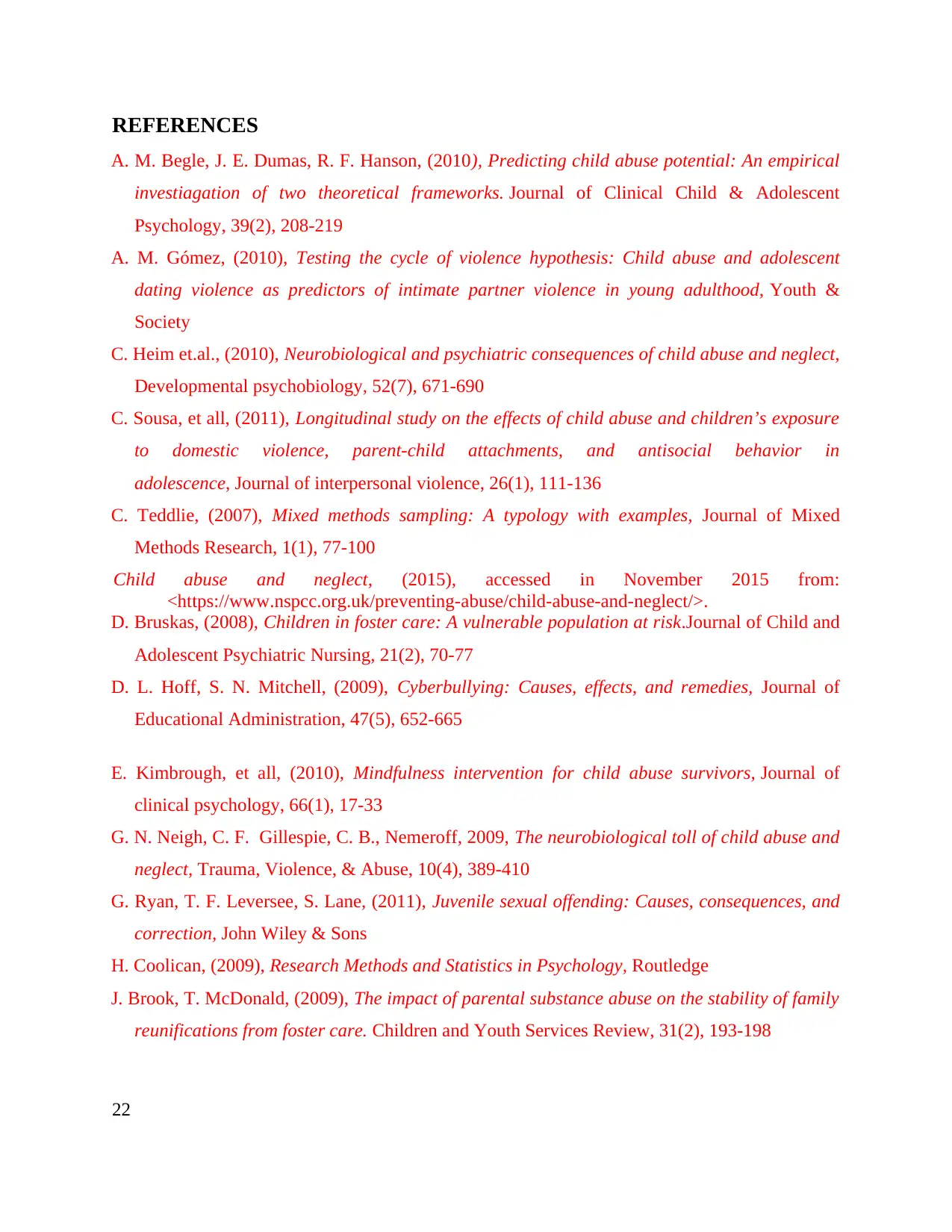
REFERENCES
A. M. Begle, J. E. Dumas, R. F. Hanson, (2010), Predicting child abuse potential: An empirical
investiagation of two theoretical frameworks. Journal of Clinical Child & Adolescent
Psychology, 39(2), 208-219
A. M. Gómez, (2010), Testing the cycle of violence hypothesis: Child abuse and adolescent
dating violence as predictors of intimate partner violence in young adulthood, Youth &
Society
C. Heim et.al., (2010), Neurobiological and psychiatric consequences of child abuse and neglect,
Developmental psychobiology, 52(7), 671-690
C. Sousa, et all, (2011), Longitudinal study on the effects of child abuse and children’s exposure
to domestic violence, parent-child attachments, and antisocial behavior in
adolescence, Journal of interpersonal violence, 26(1), 111-136
C. Teddlie, (2007), Mixed methods sampling: A typology with examples, Journal of Mixed
Methods Research, 1(1), 77-100
Child abuse and neglect, (2015), accessed in November 2015 from:
<https://www.nspcc.org.uk/preventing-abuse/child-abuse-and-neglect/>.
D. Bruskas, (2008), Children in foster care: A vulnerable population at risk.Journal of Child and
Adolescent Psychiatric Nursing, 21(2), 70-77
D. L. Hoff, S. N. Mitchell, (2009), Cyberbullying: Causes, effects, and remedies, Journal of
Educational Administration, 47(5), 652-665
E. Kimbrough, et all, (2010), Mindfulness intervention for child abuse survivors, Journal of
clinical psychology, 66(1), 17-33
G. N. Neigh, C. F. Gillespie, C. B., Nemeroff, 2009, The neurobiological toll of child abuse and
neglect, Trauma, Violence, & Abuse, 10(4), 389-410
G. Ryan, T. F. Leversee, S. Lane, (2011), Juvenile sexual offending: Causes, consequences, and
correction, John Wiley & Sons
H. Coolican, (2009), Research Methods and Statistics in Psychology, Routledge
J. Brook, T. McDonald, (2009), The impact of parental substance abuse on the stability of family
reunifications from foster care. Children and Youth Services Review, 31(2), 193-198
22
A. M. Begle, J. E. Dumas, R. F. Hanson, (2010), Predicting child abuse potential: An empirical
investiagation of two theoretical frameworks. Journal of Clinical Child & Adolescent
Psychology, 39(2), 208-219
A. M. Gómez, (2010), Testing the cycle of violence hypothesis: Child abuse and adolescent
dating violence as predictors of intimate partner violence in young adulthood, Youth &
Society
C. Heim et.al., (2010), Neurobiological and psychiatric consequences of child abuse and neglect,
Developmental psychobiology, 52(7), 671-690
C. Sousa, et all, (2011), Longitudinal study on the effects of child abuse and children’s exposure
to domestic violence, parent-child attachments, and antisocial behavior in
adolescence, Journal of interpersonal violence, 26(1), 111-136
C. Teddlie, (2007), Mixed methods sampling: A typology with examples, Journal of Mixed
Methods Research, 1(1), 77-100
Child abuse and neglect, (2015), accessed in November 2015 from:
<https://www.nspcc.org.uk/preventing-abuse/child-abuse-and-neglect/>.
D. Bruskas, (2008), Children in foster care: A vulnerable population at risk.Journal of Child and
Adolescent Psychiatric Nursing, 21(2), 70-77
D. L. Hoff, S. N. Mitchell, (2009), Cyberbullying: Causes, effects, and remedies, Journal of
Educational Administration, 47(5), 652-665
E. Kimbrough, et all, (2010), Mindfulness intervention for child abuse survivors, Journal of
clinical psychology, 66(1), 17-33
G. N. Neigh, C. F. Gillespie, C. B., Nemeroff, 2009, The neurobiological toll of child abuse and
neglect, Trauma, Violence, & Abuse, 10(4), 389-410
G. Ryan, T. F. Leversee, S. Lane, (2011), Juvenile sexual offending: Causes, consequences, and
correction, John Wiley & Sons
H. Coolican, (2009), Research Methods and Statistics in Psychology, Routledge
J. Brook, T. McDonald, (2009), The impact of parental substance abuse on the stability of family
reunifications from foster care. Children and Youth Services Review, 31(2), 193-198
22
Secure Best Marks with AI Grader
Need help grading? Try our AI Grader for instant feedback on your assignments.
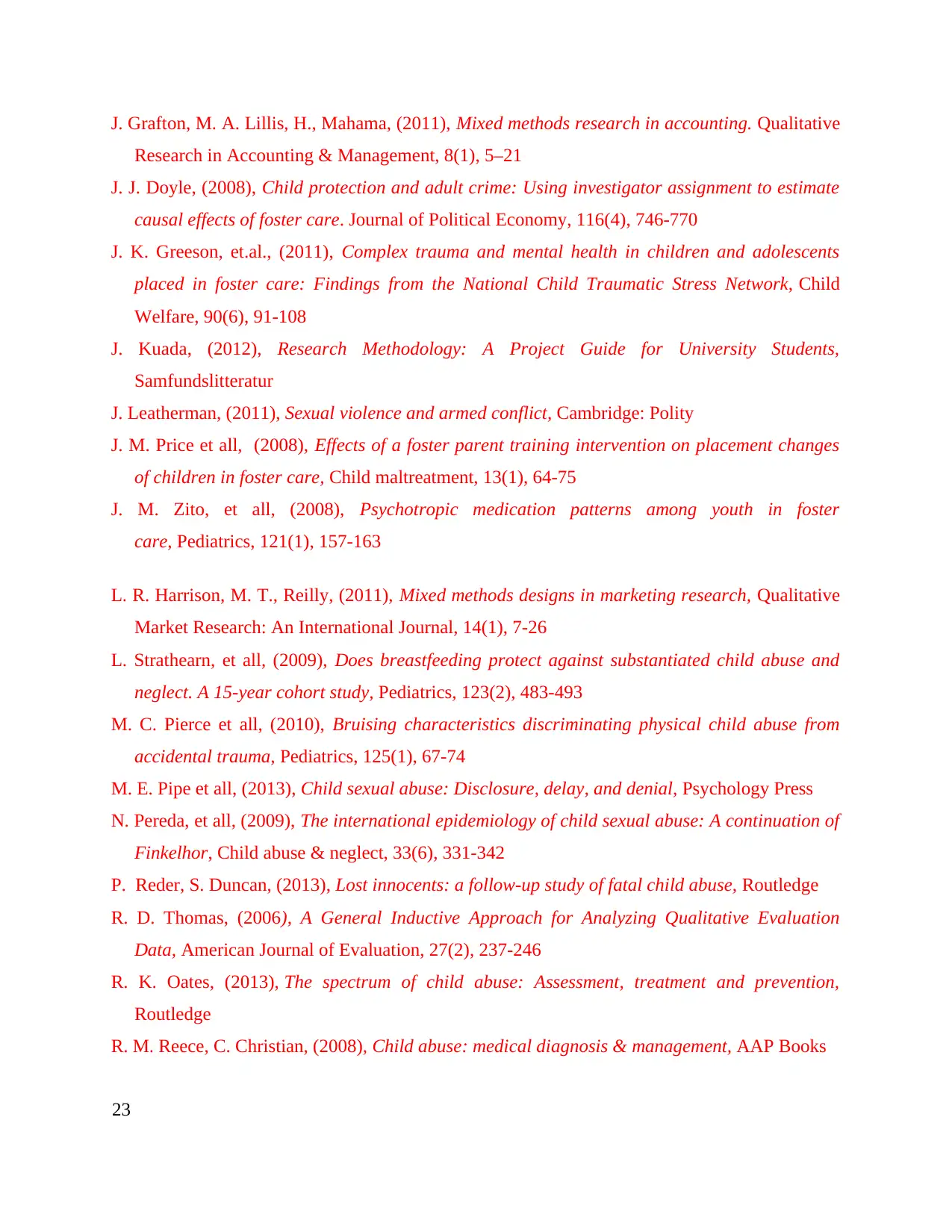
J. Grafton, M. A. Lillis, H., Mahama, (2011), Mixed methods research in accounting. Qualitative
Research in Accounting & Management, 8(1), 5–21
J. J. Doyle, (2008), Child protection and adult crime: Using investigator assignment to estimate
causal effects of foster care. Journal of Political Economy, 116(4), 746-770
J. K. Greeson, et.al., (2011), Complex trauma and mental health in children and adolescents
placed in foster care: Findings from the National Child Traumatic Stress Network, Child
Welfare, 90(6), 91-108
J. Kuada, (2012), Research Methodology: A Project Guide for University Students,
Samfundslitteratur
J. Leatherman, (2011), Sexual violence and armed conflict, Cambridge: Polity
J. M. Price et all, (2008), Effects of a foster parent training intervention on placement changes
of children in foster care, Child maltreatment, 13(1), 64-75
J. M. Zito, et all, (2008), Psychotropic medication patterns among youth in foster
care, Pediatrics, 121(1), 157-163
L. R. Harrison, M. T., Reilly, (2011), Mixed methods designs in marketing research, Qualitative
Market Research: An International Journal, 14(1), 7-26
L. Strathearn, et all, (2009), Does breastfeeding protect against substantiated child abuse and
neglect. A 15-year cohort study, Pediatrics, 123(2), 483-493
M. C. Pierce et all, (2010), Bruising characteristics discriminating physical child abuse from
accidental trauma, Pediatrics, 125(1), 67-74
M. E. Pipe et all, (2013), Child sexual abuse: Disclosure, delay, and denial, Psychology Press
N. Pereda, et all, (2009), The international epidemiology of child sexual abuse: A continuation of
Finkelhor, Child abuse & neglect, 33(6), 331-342
P. Reder, S. Duncan, (2013), Lost innocents: a follow-up study of fatal child abuse, Routledge
R. D. Thomas, (2006), A General Inductive Approach for Analyzing Qualitative Evaluation
Data, American Journal of Evaluation, 27(2), 237-246
R. K. Oates, (2013), The spectrum of child abuse: Assessment, treatment and prevention,
Routledge
R. M. Reece, C. Christian, (2008), Child abuse: medical diagnosis & management, AAP Books
23
Research in Accounting & Management, 8(1), 5–21
J. J. Doyle, (2008), Child protection and adult crime: Using investigator assignment to estimate
causal effects of foster care. Journal of Political Economy, 116(4), 746-770
J. K. Greeson, et.al., (2011), Complex trauma and mental health in children and adolescents
placed in foster care: Findings from the National Child Traumatic Stress Network, Child
Welfare, 90(6), 91-108
J. Kuada, (2012), Research Methodology: A Project Guide for University Students,
Samfundslitteratur
J. Leatherman, (2011), Sexual violence and armed conflict, Cambridge: Polity
J. M. Price et all, (2008), Effects of a foster parent training intervention on placement changes
of children in foster care, Child maltreatment, 13(1), 64-75
J. M. Zito, et all, (2008), Psychotropic medication patterns among youth in foster
care, Pediatrics, 121(1), 157-163
L. R. Harrison, M. T., Reilly, (2011), Mixed methods designs in marketing research, Qualitative
Market Research: An International Journal, 14(1), 7-26
L. Strathearn, et all, (2009), Does breastfeeding protect against substantiated child abuse and
neglect. A 15-year cohort study, Pediatrics, 123(2), 483-493
M. C. Pierce et all, (2010), Bruising characteristics discriminating physical child abuse from
accidental trauma, Pediatrics, 125(1), 67-74
M. E. Pipe et all, (2013), Child sexual abuse: Disclosure, delay, and denial, Psychology Press
N. Pereda, et all, (2009), The international epidemiology of child sexual abuse: A continuation of
Finkelhor, Child abuse & neglect, 33(6), 331-342
P. Reder, S. Duncan, (2013), Lost innocents: a follow-up study of fatal child abuse, Routledge
R. D. Thomas, (2006), A General Inductive Approach for Analyzing Qualitative Evaluation
Data, American Journal of Evaluation, 27(2), 237-246
R. K. Oates, (2013), The spectrum of child abuse: Assessment, treatment and prevention,
Routledge
R. M. Reece, C. Christian, (2008), Child abuse: medical diagnosis & management, AAP Books
23
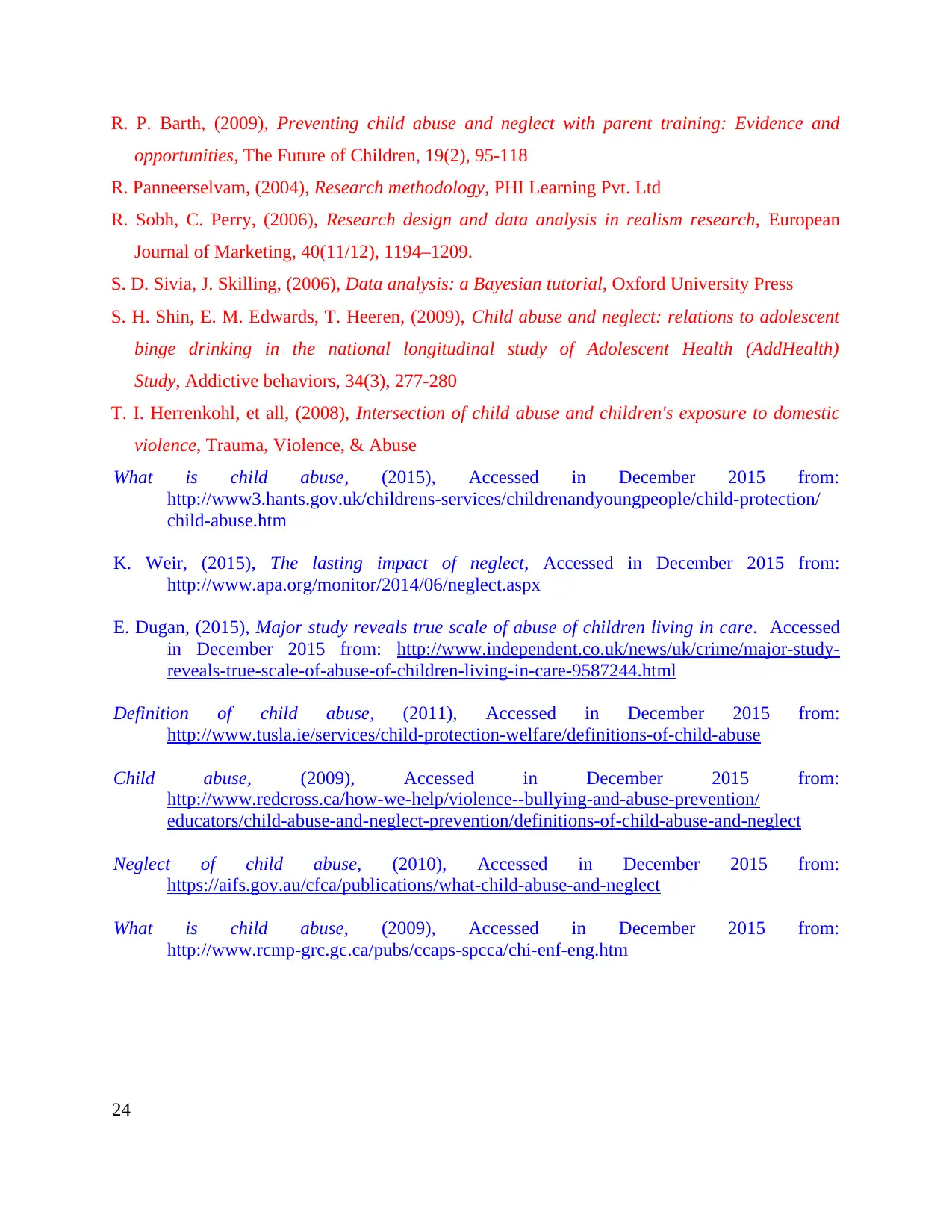
R. P. Barth, (2009), Preventing child abuse and neglect with parent training: Evidence and
opportunities, The Future of Children, 19(2), 95-118
R. Panneerselvam, (2004), Research methodology, PHI Learning Pvt. Ltd
R. Sobh, C. Perry, (2006), Research design and data analysis in realism research, European
Journal of Marketing, 40(11/12), 1194–1209.
S. D. Sivia, J. Skilling, (2006), Data analysis: a Bayesian tutorial, Oxford University Press
S. H. Shin, E. M. Edwards, T. Heeren, (2009), Child abuse and neglect: relations to adolescent
binge drinking in the national longitudinal study of Adolescent Health (AddHealth)
Study, Addictive behaviors, 34(3), 277-280
T. I. Herrenkohl, et all, (2008), Intersection of child abuse and children's exposure to domestic
violence, Trauma, Violence, & Abuse
What is child abuse, (2015), Accessed in December 2015 from:
http://www3.hants.gov.uk/childrens-services/childrenandyoungpeople/child-protection/
child-abuse.htm
K. Weir, (2015), The lasting impact of neglect, Accessed in December 2015 from:
http://www.apa.org/monitor/2014/06/neglect.aspx
E. Dugan, (2015), Major study reveals true scale of abuse of children living in care. Accessed
in December 2015 from: http://www.independent.co.uk/news/uk/crime/major-study-
reveals-true-scale-of-abuse-of-children-living-in-care-9587244.html
Definition of child abuse, (2011), Accessed in December 2015 from:
http://www.tusla.ie/services/child-protection-welfare/definitions-of-child-abuse
Child abuse, (2009), Accessed in December 2015 from:
http://www.redcross.ca/how-we-help/violence--bullying-and-abuse-prevention/
educators/child-abuse-and-neglect-prevention/definitions-of-child-abuse-and-neglect
Neglect of child abuse, (2010), Accessed in December 2015 from:
https://aifs.gov.au/cfca/publications/what-child-abuse-and-neglect
What is child abuse, (2009), Accessed in December 2015 from:
http://www.rcmp-grc.gc.ca/pubs/ccaps-spcca/chi-enf-eng.htm
24
opportunities, The Future of Children, 19(2), 95-118
R. Panneerselvam, (2004), Research methodology, PHI Learning Pvt. Ltd
R. Sobh, C. Perry, (2006), Research design and data analysis in realism research, European
Journal of Marketing, 40(11/12), 1194–1209.
S. D. Sivia, J. Skilling, (2006), Data analysis: a Bayesian tutorial, Oxford University Press
S. H. Shin, E. M. Edwards, T. Heeren, (2009), Child abuse and neglect: relations to adolescent
binge drinking in the national longitudinal study of Adolescent Health (AddHealth)
Study, Addictive behaviors, 34(3), 277-280
T. I. Herrenkohl, et all, (2008), Intersection of child abuse and children's exposure to domestic
violence, Trauma, Violence, & Abuse
What is child abuse, (2015), Accessed in December 2015 from:
http://www3.hants.gov.uk/childrens-services/childrenandyoungpeople/child-protection/
child-abuse.htm
K. Weir, (2015), The lasting impact of neglect, Accessed in December 2015 from:
http://www.apa.org/monitor/2014/06/neglect.aspx
E. Dugan, (2015), Major study reveals true scale of abuse of children living in care. Accessed
in December 2015 from: http://www.independent.co.uk/news/uk/crime/major-study-
reveals-true-scale-of-abuse-of-children-living-in-care-9587244.html
Definition of child abuse, (2011), Accessed in December 2015 from:
http://www.tusla.ie/services/child-protection-welfare/definitions-of-child-abuse
Child abuse, (2009), Accessed in December 2015 from:
http://www.redcross.ca/how-we-help/violence--bullying-and-abuse-prevention/
educators/child-abuse-and-neglect-prevention/definitions-of-child-abuse-and-neglect
Neglect of child abuse, (2010), Accessed in December 2015 from:
https://aifs.gov.au/cfca/publications/what-child-abuse-and-neglect
What is child abuse, (2009), Accessed in December 2015 from:
http://www.rcmp-grc.gc.ca/pubs/ccaps-spcca/chi-enf-eng.htm
24

APPENDIX 1- METHOD USED TO FIND QUALITATIVE DATA
25
25
Paraphrase This Document
Need a fresh take? Get an instant paraphrase of this document with our AI Paraphraser
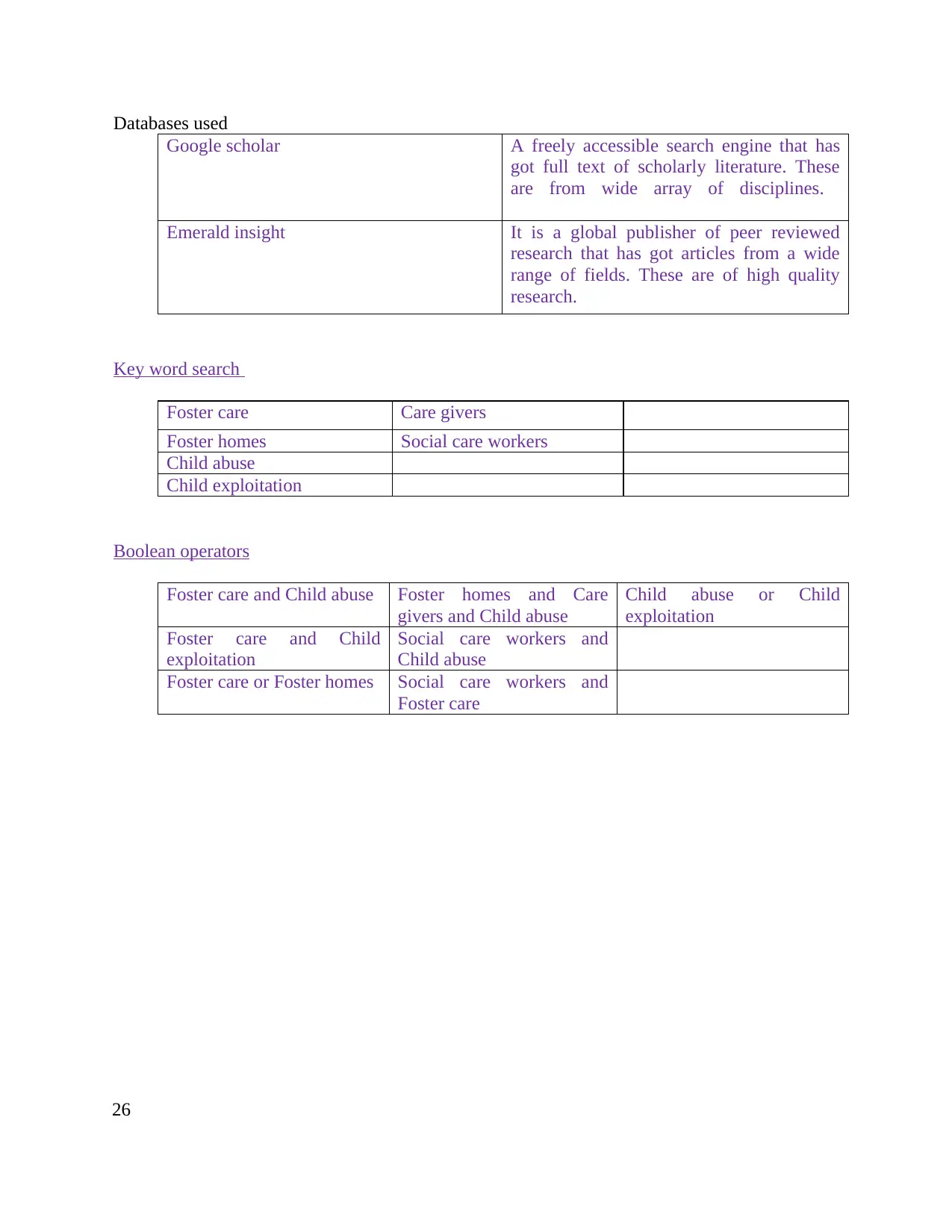
Databases used
Google scholar A freely accessible search engine that has
got full text of scholarly literature. These
are from wide array of disciplines.
Emerald insight It is a global publisher of peer reviewed
research that has got articles from a wide
range of fields. These are of high quality
research.
Key word search
Foster care Care givers
Foster homes Social care workers
Child abuse
Child exploitation
Boolean operators
Foster care and Child abuse Foster homes and Care
givers and Child abuse
Child abuse or Child
exploitation
Foster care and Child
exploitation
Social care workers and
Child abuse
Foster care or Foster homes Social care workers and
Foster care
26
Google scholar A freely accessible search engine that has
got full text of scholarly literature. These
are from wide array of disciplines.
Emerald insight It is a global publisher of peer reviewed
research that has got articles from a wide
range of fields. These are of high quality
research.
Key word search
Foster care Care givers
Foster homes Social care workers
Child abuse
Child exploitation
Boolean operators
Foster care and Child abuse Foster homes and Care
givers and Child abuse
Child abuse or Child
exploitation
Foster care and Child
exploitation
Social care workers and
Child abuse
Foster care or Foster homes Social care workers and
Foster care
26
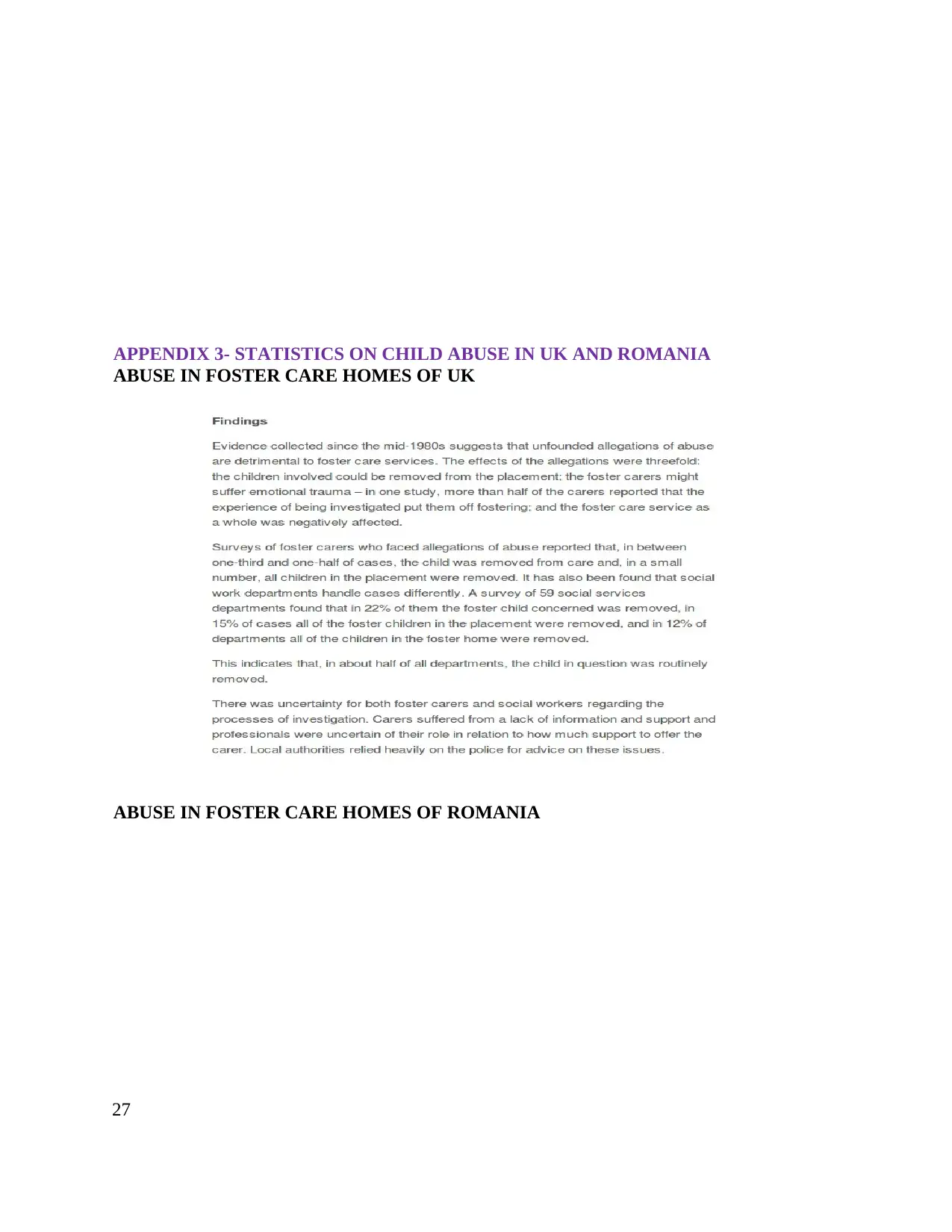
APPENDIX 3- STATISTICS ON CHILD ABUSE IN UK AND ROMANIA
ABUSE IN FOSTER CARE HOMES OF UK
ABUSE IN FOSTER CARE HOMES OF ROMANIA
27
ABUSE IN FOSTER CARE HOMES OF UK
ABUSE IN FOSTER CARE HOMES OF ROMANIA
27

Figure 1 Cases of abuse in Romanian foster and
28
28
1 out of 28
Related Documents
Your All-in-One AI-Powered Toolkit for Academic Success.
+13062052269
info@desklib.com
Available 24*7 on WhatsApp / Email
![[object Object]](/_next/static/media/star-bottom.7253800d.svg)
Unlock your academic potential
© 2024 | Zucol Services PVT LTD | All rights reserved.




